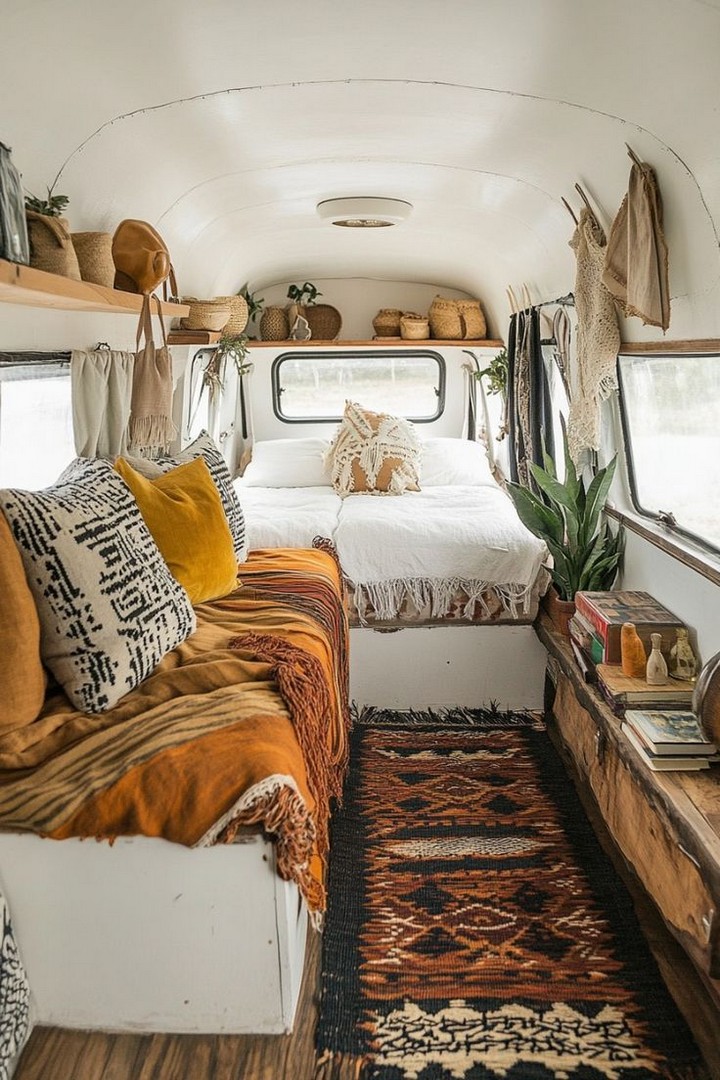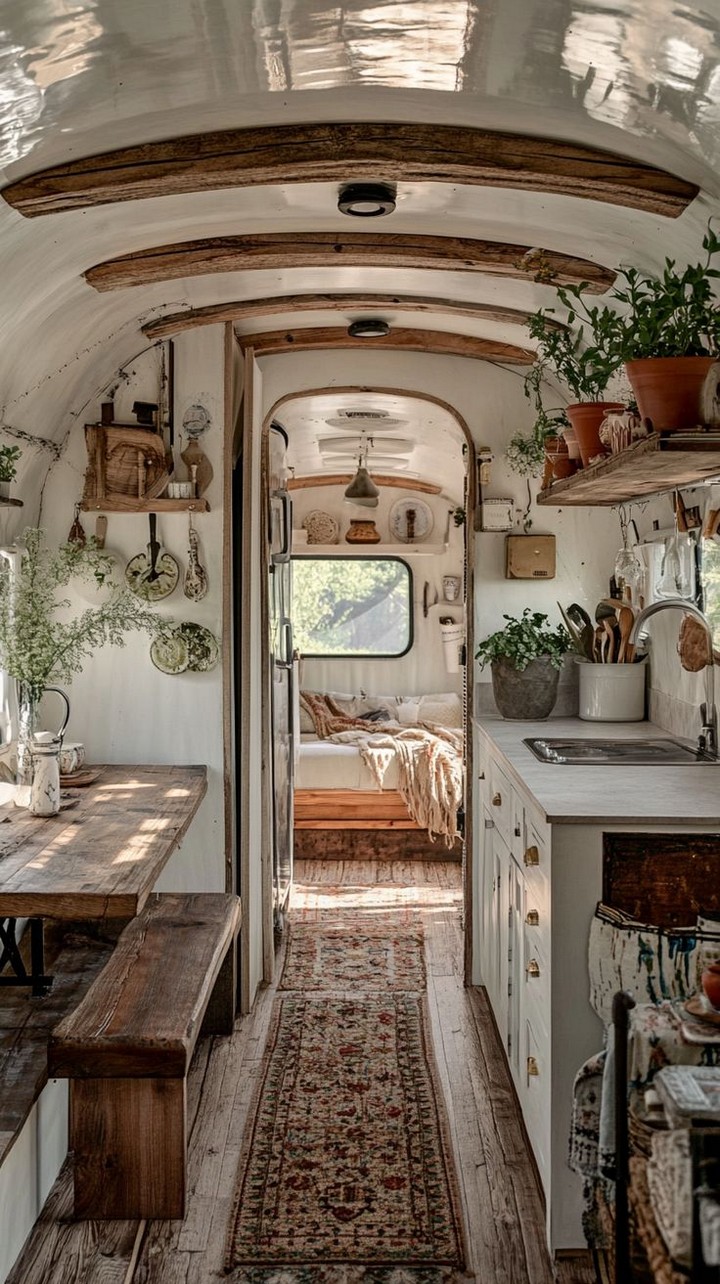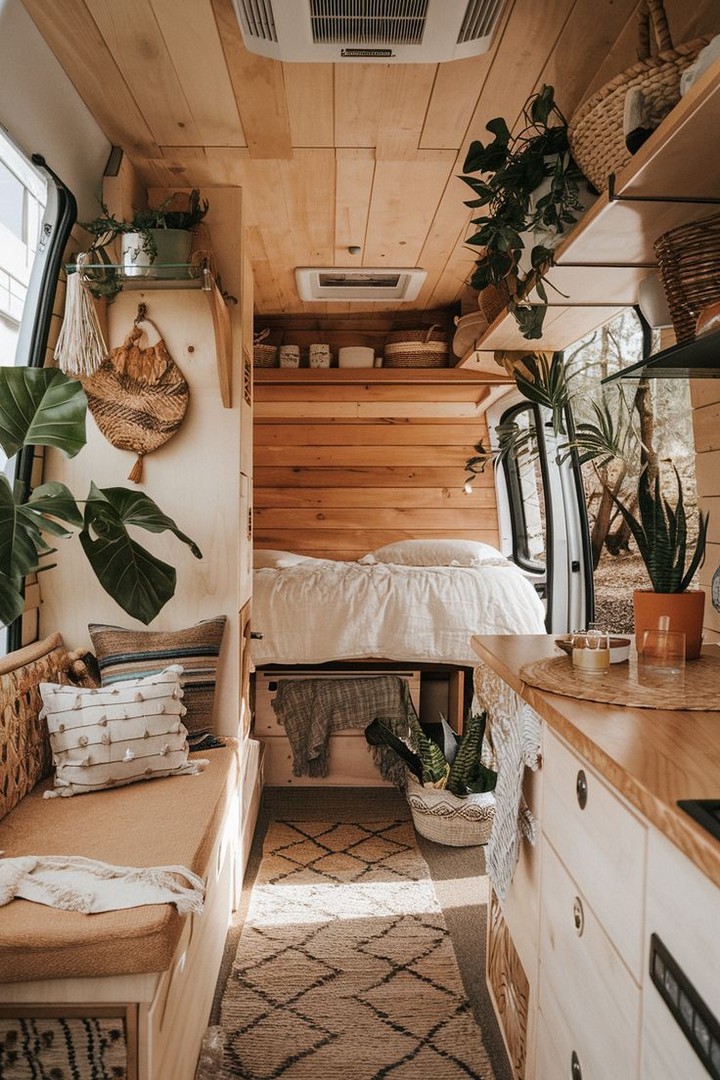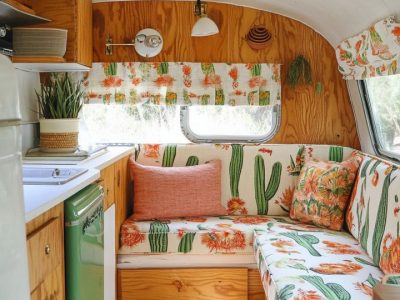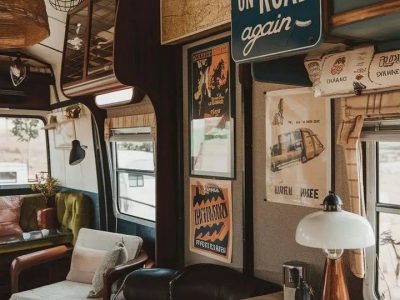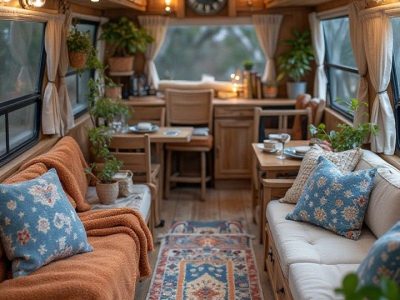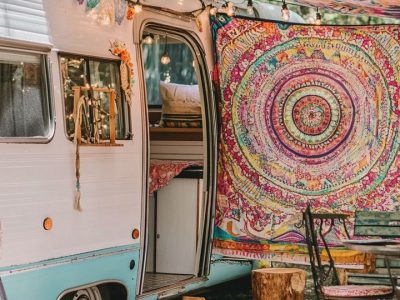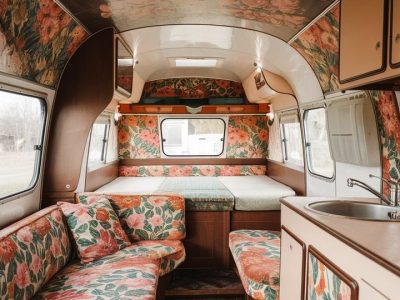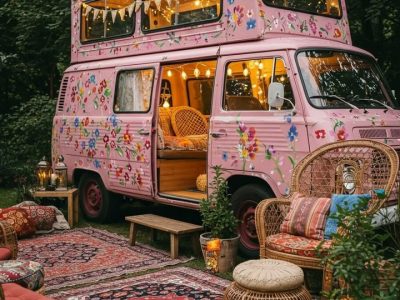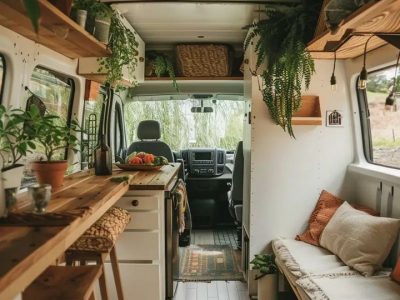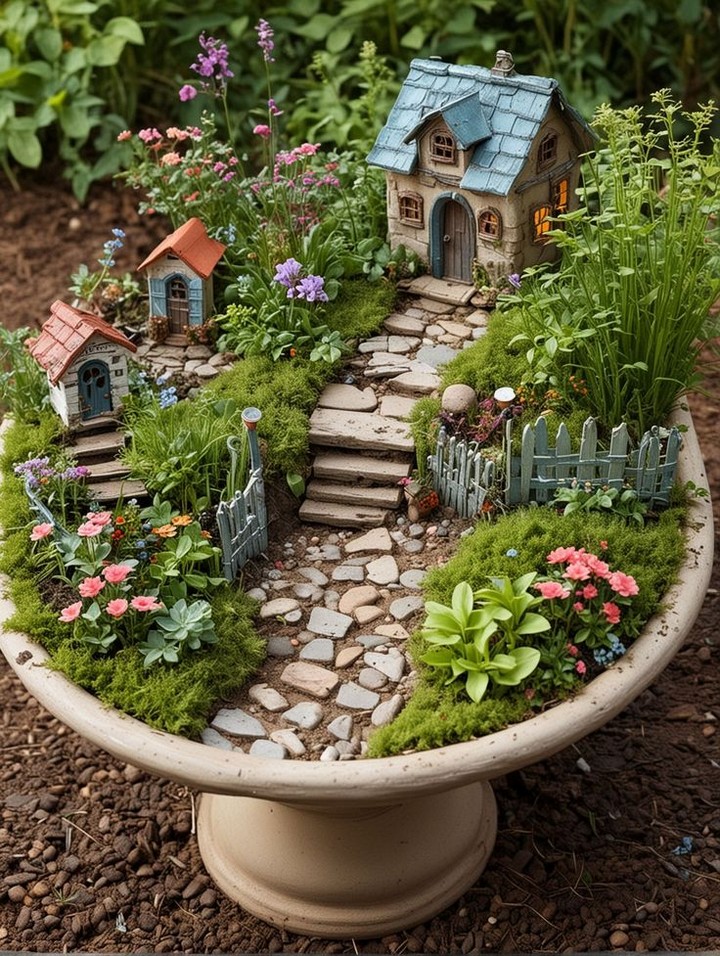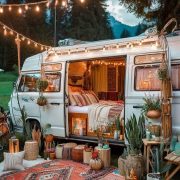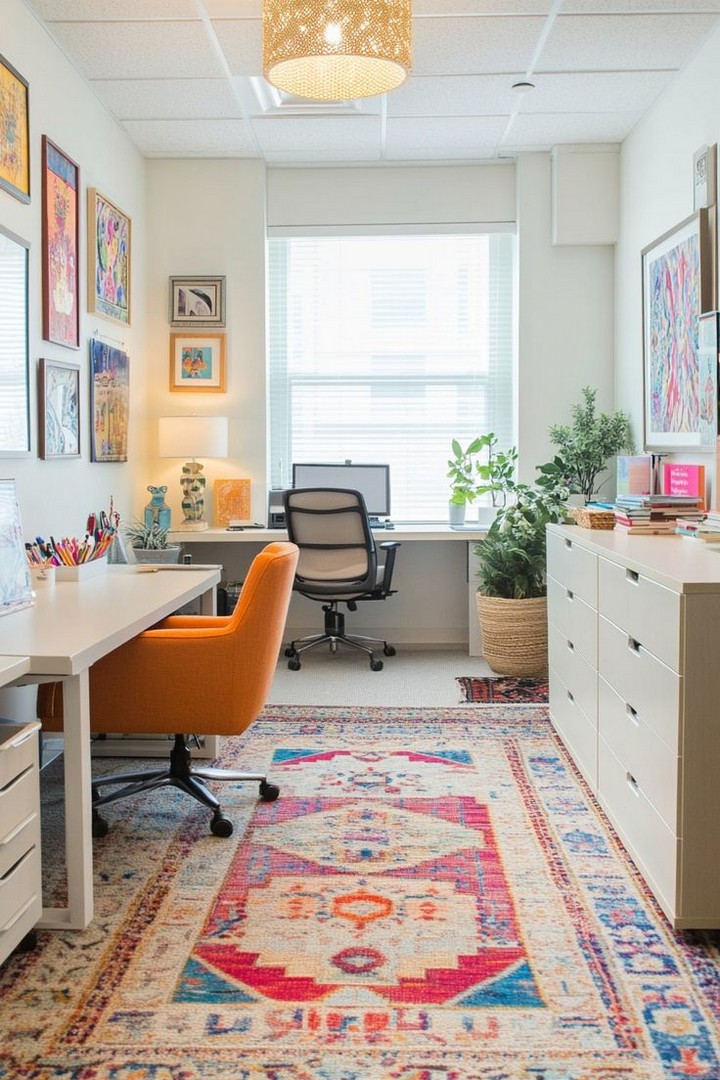Skoolies (converted school buses) have exploded in popularity as affordable, customizable, and adventurous tiny homes on wheels. Whether you’re a full-time nomad, weekend traveler, or DIY enthusiast, a skoolie conversion offers endless possibilities for creative living.
The humble yellow school bus once filled with the chatter of students is finding an exciting second life as the foundation for creative, mobile living spaces. The “skoolie” movement has exploded in popularity as more people discover the freedom, affordability, and endless customization possibilities these sturdy vehicles offer. From minimalist designs to elaborate tiny homes on wheels, skoolies represent the perfect blank canvas for expressing personal style while embracing alternative living.
In this ultimate guide, we’ll explore 35 fun and functional skoolie concepts, from bohemian retreats to high-tech mobile homes. Get ready to be inspired by layouts, decor ideas, and smart space-saving hacks that transform an old bus into your dream home!
Why Choose a Skoolie?
🚌 Affordable Alternative – Cheaper than RVs or traditional homes.
🛠️ Endless Customization – Design it exactly how you want.
🌍 Adventure-Ready – Travel anywhere while keeping home comforts.
♻️ Eco-Friendly – Repurposing reduces waste.
Now, let’s dive into 35 unique skoolie remodel ideas!
Innovative Floor Plans
1. The Open Concept Studio
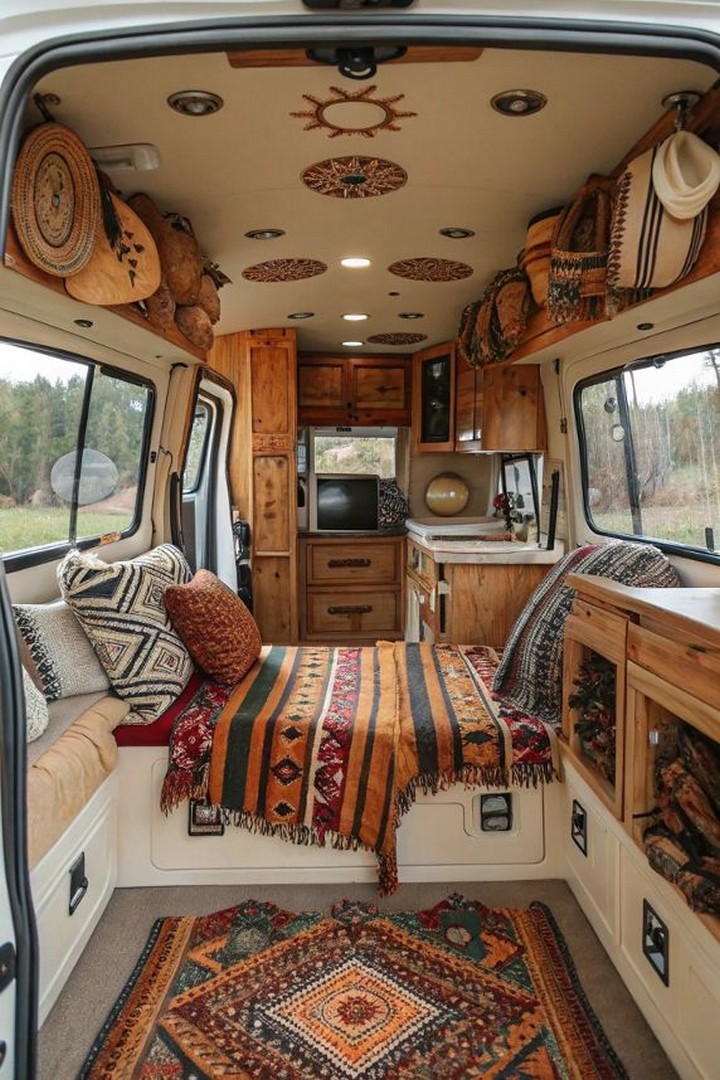
Traditional bus seating arrangements create natural divisions, but removing these barriers creates a flowing, open-concept living space. This approach maximizes the perception of space by maintaining clear sightlines from the front to the back of the bus.
In open-concept skoolies, multifunctional furniture takes center stage. Think convertible sofas that transform into guest beds, dining tables that double as workstations, and kitchen islands that serve as both food prep areas and social gathering spots. The key to successful open-concept design lies in creating subtle zone distinctions through area rugs, ceiling treatments, or changes in flooring direction rather than physical walls.
2. The Sectional Suite

For families or those desiring more privacy, sectioning the bus into distinct “rooms” creates a more traditional living experience. This approach utilizes partial walls, curtains, sliding doors, or elevation changes to define separate spaces while maintaining the vehicle’s cohesive feel.
A popular sectional layout includes a master bedroom at the rear, a bathroom/utility zone mid-bus, and living/kitchen areas toward the front. This arrangement mimics traditional home flow while working with the natural dimensions and features of the bus structure.
3. The Elevated Bedroom Platform
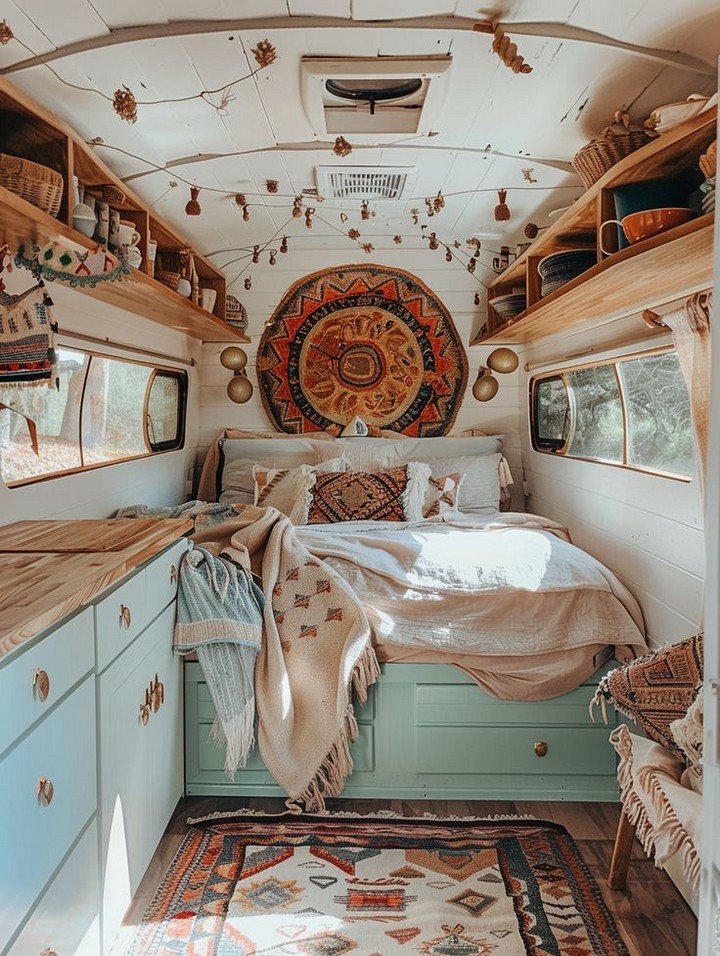
Raising the bed area creates valuable storage space underneath a smart solution for maximizing every cubic inch in a skoolie. Platforms typically range from 18-36 inches in height, with the space below accommodating drawers, pull-out storage systems, or even mechanicals like water tanks and electrical components.
The elevated platform can create a cozy sleeping nook with a built-in feel, especially when paired with reading lights and small storage niches for books and personal items. Some conversions extend this platform partially across the width of the bus, creating a split-level effect that adds visual interest and functional zoning.
4. The Convertible Multi-Use Space
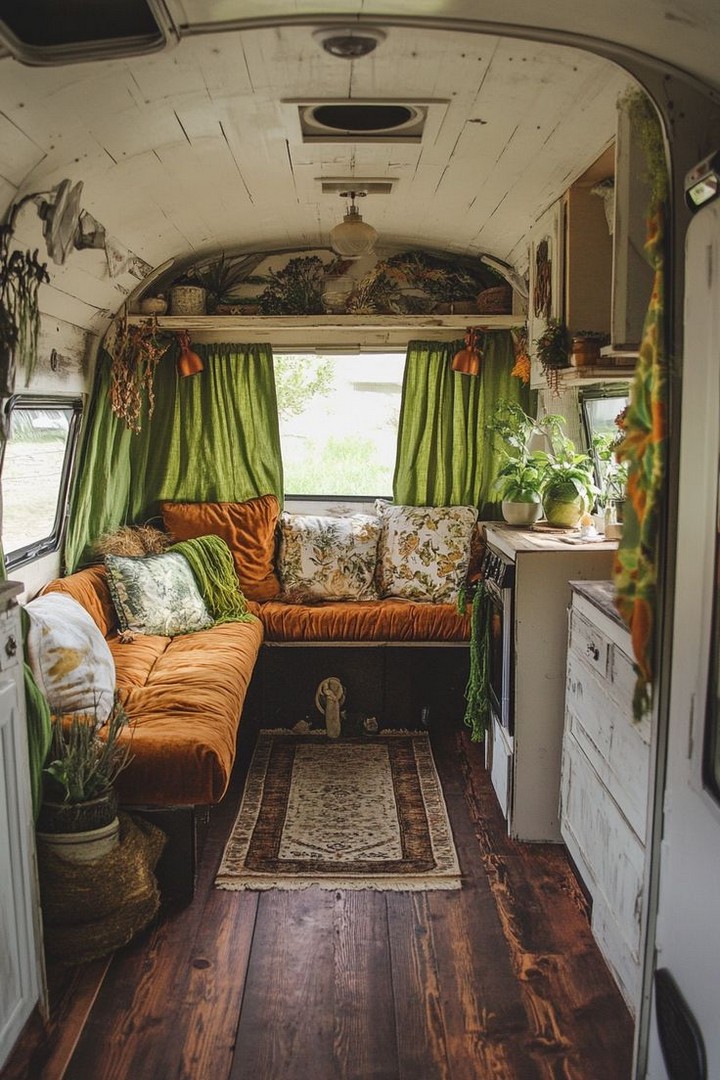
Perfect for smaller buses or those seeking maximum versatility, this concept focuses on transformable areas that serve multiple functions throughout the day. Furniture and fixtures fold, slide, or otherwise transform to accommodate different activities.
Examples include Murphy beds that tuck away to reveal workspaces, dining tables that lower to become bed platforms, and seating with storage that converts to guest sleeping quarters. This approach requires careful planning and quality hardware but rewards with unparalleled flexibility in limited square footage.
5. The Rear Garage Concept
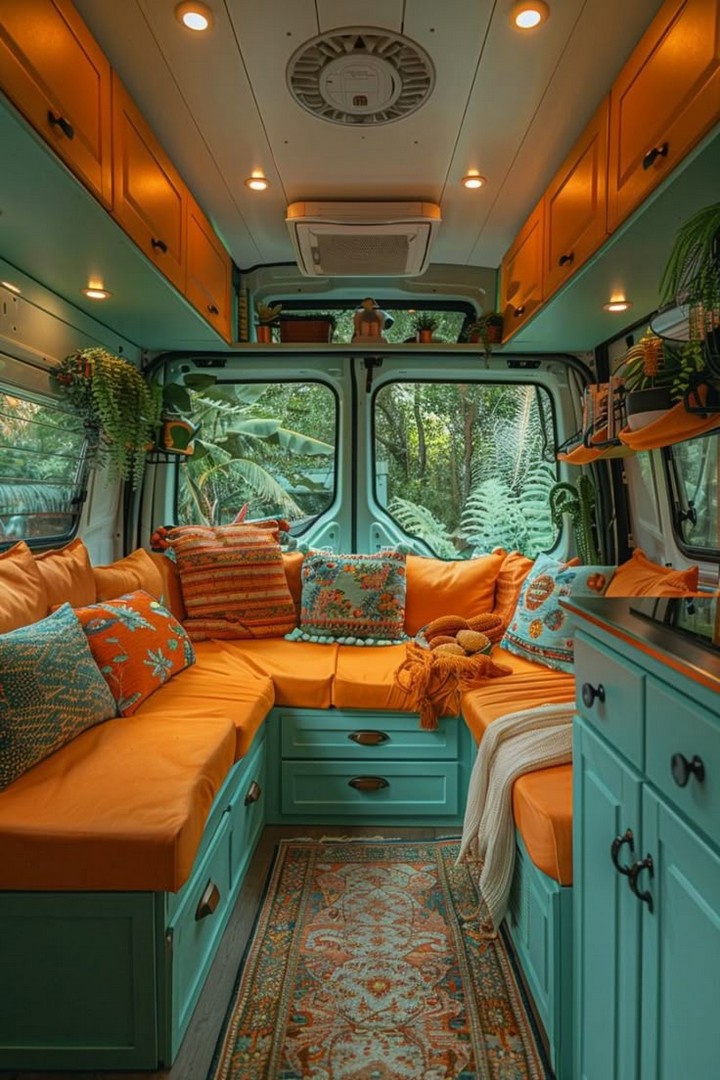
Adventure enthusiasts often incorporate a “garage” area at the rear of the bus for storing outdoor gear, bicycles, motorcycles, or sports equipment. This designated space typically includes specialized racks, tie-downs, and access via the bus’s emergency door.
The garage zone may include a workbench for equipment maintenance or creative projects, making it not just storage but a functional workshop. Many designs incorporate a barrier between living and garage spaces that can be opened to extend indoor areas when equipment is unloaded during stationary periods.
Creative Kitchen Designs
6. The Galley Kitchen Layout
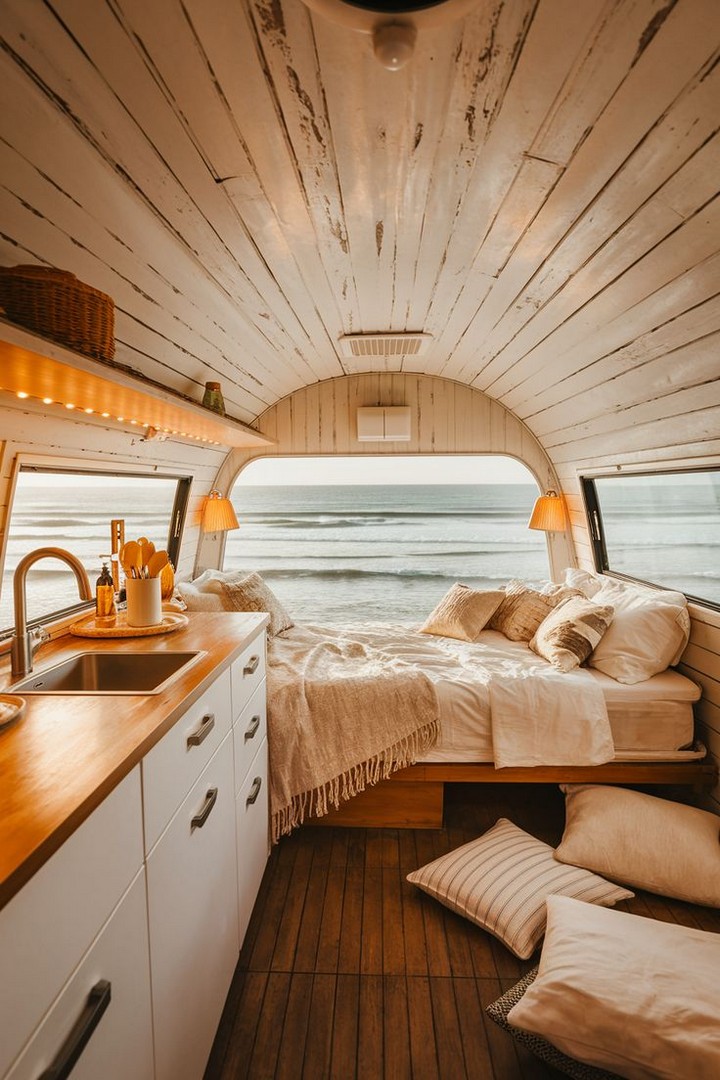
Drawing inspiration from boat design, galley kitchens in skoolies typically run along one side of the bus, creating an efficient cooking space that doesn’t obstruct the main traffic flow. This linear arrangement places appliances, sink, and prep areas in a logical workflow sequence.
Successful galley designs maximize vertical space with ceiling-height cabinets, magnetic knife strips, and hanging storage for frequently used items. Window placement is crucial—maintaining natural light above countertops enhances the cooking experience while preventing the space from feeling confined.
7. The Kitchen Island Centerpiece
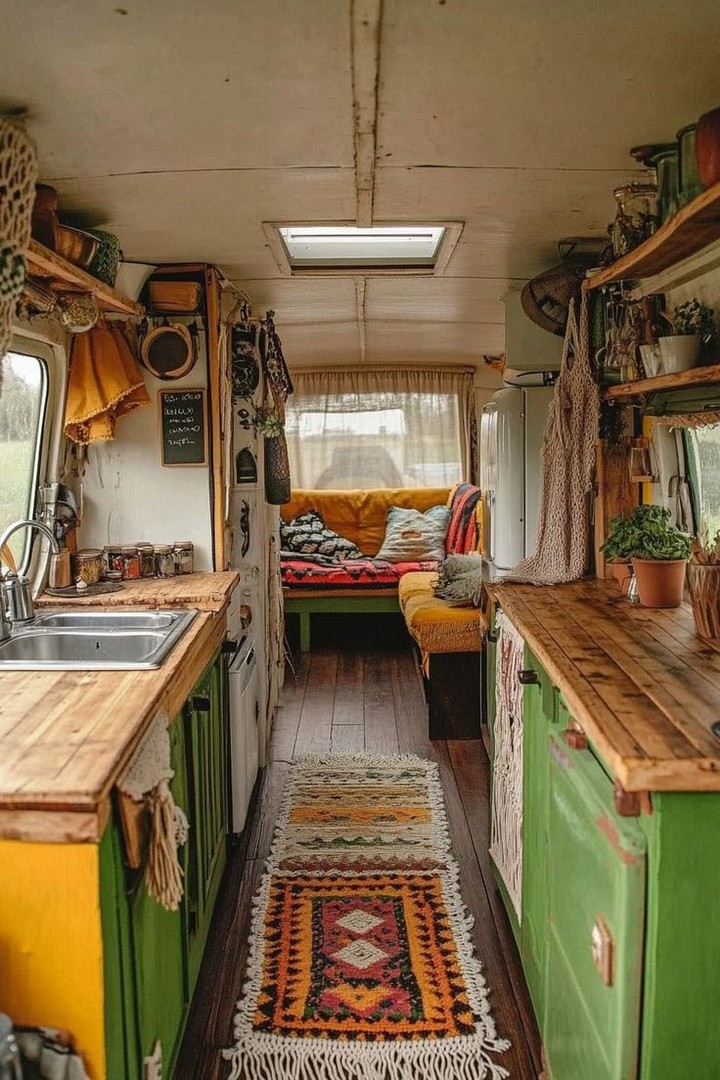
For those prioritizing culinary experiences, a central island creates additional workspace and storage while serving as a natural gathering point. In wider bus models, islands can include a small sink, cooktop, or seating area on one side.
The island concept works particularly well in open floor plans, helping define the kitchen zone without walled barriers. Wheels on the island base allow for reconfiguration when needed, adding valuable flexibility to the layout.
8. The Indoor-Outdoor Kitchen Connection
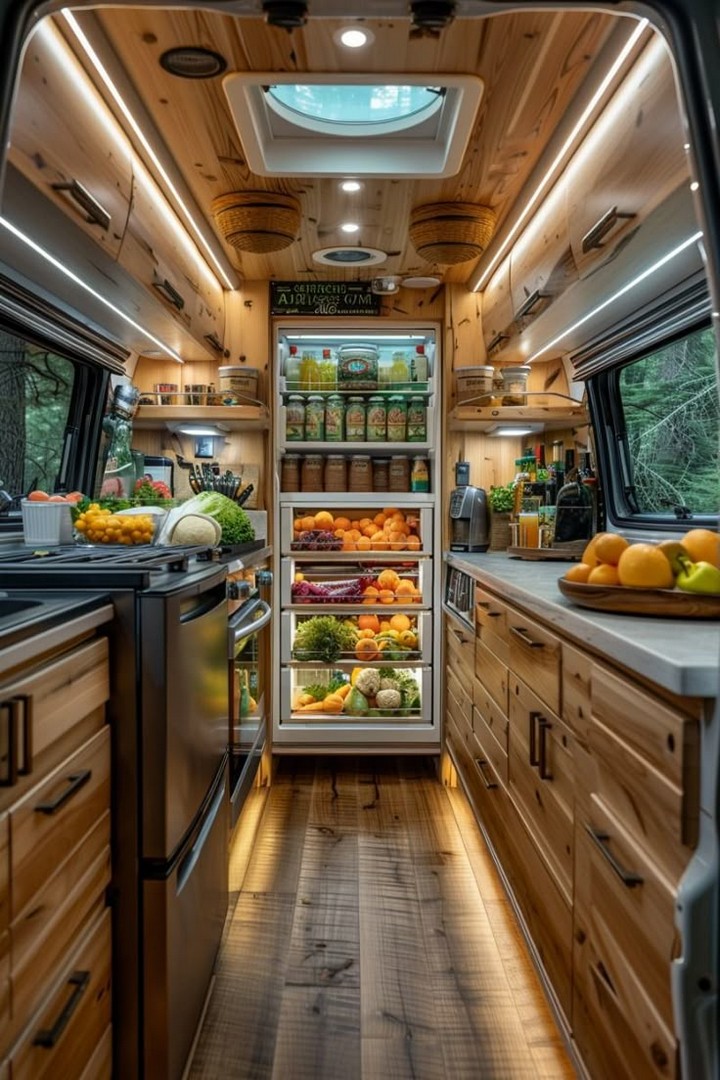
Connecting indoor cooking areas with outdoor spaces expands both living and food preparation options. This design typically features a large window or door that opens near the kitchen, sometimes with a countertop that extends outward to create an outdoor serving or prep station.
Some innovative skoolies incorporate fold-down exterior tables, slide-out cooking surfaces, or even dedicated outdoor kitchen components that store neatly when not in use. This connection to the outdoors enhances the travel experience by bringing natural elements into daily routines.
9. The Minimalist Cooking Setup
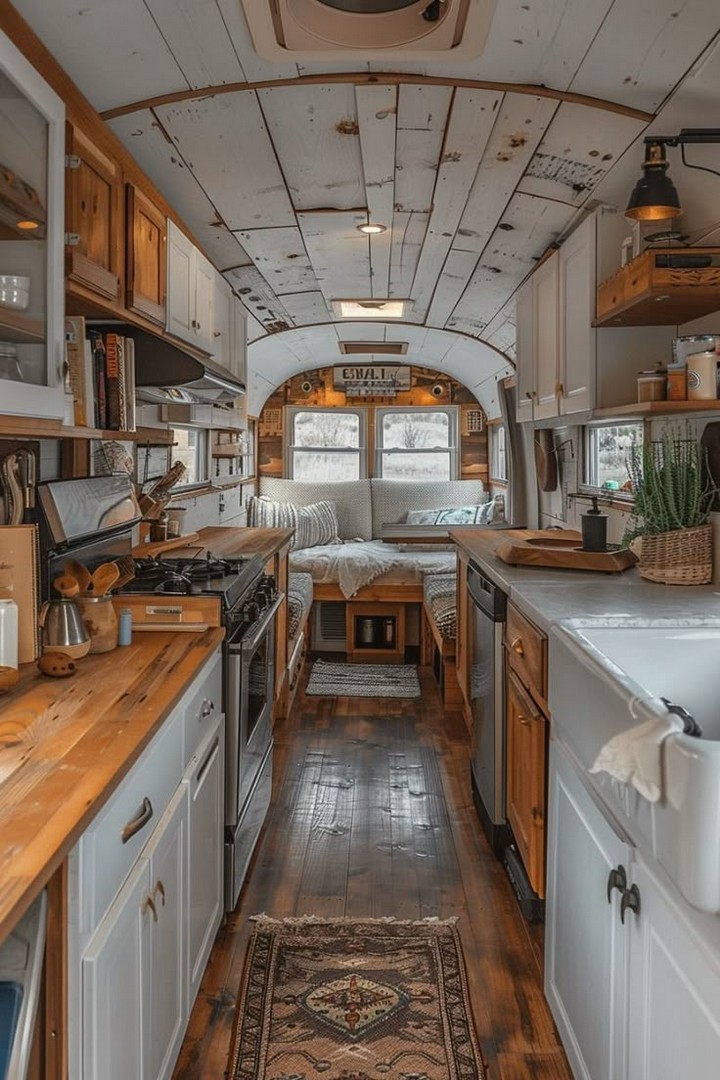
Not everyone needs extensive kitchen facilities. Minimalist approaches focus on essential functions with simplified equipment: a quality two-burner stove, compact refrigeration, basic sink, and carefully chosen multipurpose tools and cookware.
These stripped-down kitchens emphasize quality over quantity, often featuring beautiful handcrafted elements like live-edge countertops or custom tile work that elevate the simple space. Clever storage solutions prevent counter clutter, maintaining the clean aesthetic while ensuring cooking essentials remain accessible.
10. The Chef’s Bus Kitchen
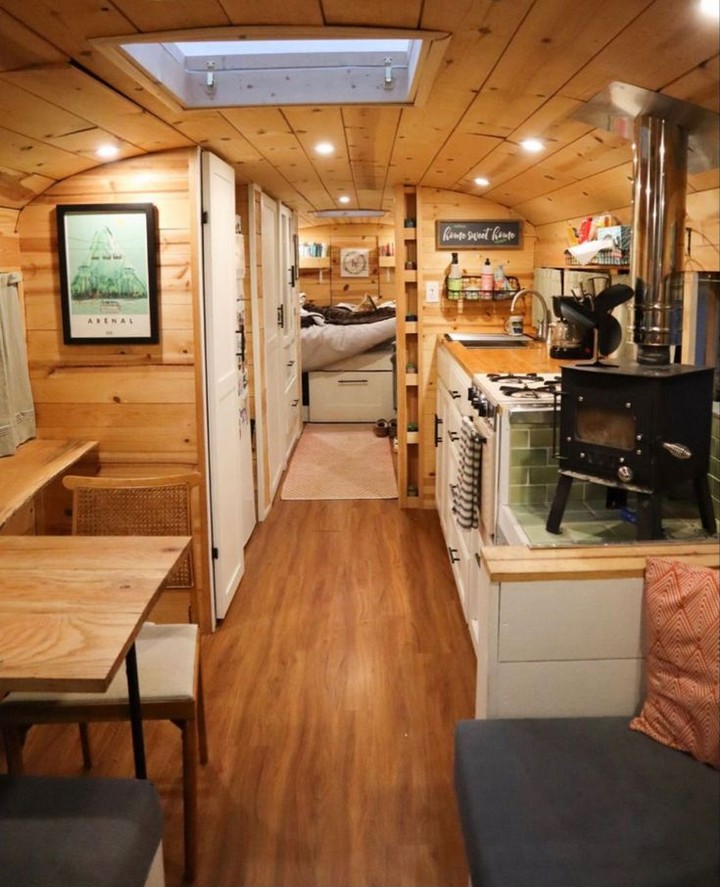
At the opposite end of the spectrum, some skoolie enthusiasts create surprisingly comprehensive cooking spaces rivaling conventional homes. These ambitious kitchens might include nearly full-sized appliances, extensive countertops, and specialized features like fermentation stations, coffee bars, or baking centers.
While these larger kitchens require sacrificing space elsewhere in the design, they reflect their owners’ priorities and lifestyles. For those who find joy and community through food preparation, the investment in a well-equipped kitchen transforms the travel experience.
Innovative Bathroom Solutions
11. The Wet Bath Design
Space efficiency meets practicality in the wet bath concept, where the entire bathroom functions as the shower enclosure. Waterproof materials throughout allow for compact design while maintaining full functionality.
Key components include a drain in the center of the floor, wall-mounted fixtures that can withstand moisture, and proper ventilation to manage humidity. When designed thoughtfully, wet baths can include surprisingly luxurious touches like rainfall showerheads, built-in niches for toiletries, and beautiful tile or sealed wood surfaces.
12. The Outdoor Shower Integration
Embracing the mobile lifestyle often means connecting with nature, and outdoor bathing options support this philosophy. External shower setups typically mount near the rear or side door, with privacy provided by attachable curtains, screens, or the natural surroundings of remote camping locations.
These systems usually connect to the bus’s main water supply but have separate drainage solutions. Many incorporate on-demand water heaters for comfort in various climates. The beauty of outdoor bathing lies in its simplicity and the unmatched experience of showering under open sky.
13. The Hidden Bathroom Compartment
For those prioritizing social spaces but still wanting onboard facilities, concealed bathrooms preserve both function and aesthetics. These designs disguise bathroom areas behind custom doors that blend with surrounding walls, under benches that lift to reveal toilet facilities, or within closet-like spaces that serve multiple purposes.
Successful hidden bathrooms require careful attention to ventilation and sealing to prevent odors or moisture from affecting adjacent living areas. The best examples feel surprisingly spacious once inside despite their compact footprint.
14. The Spa-Inspired Retreat
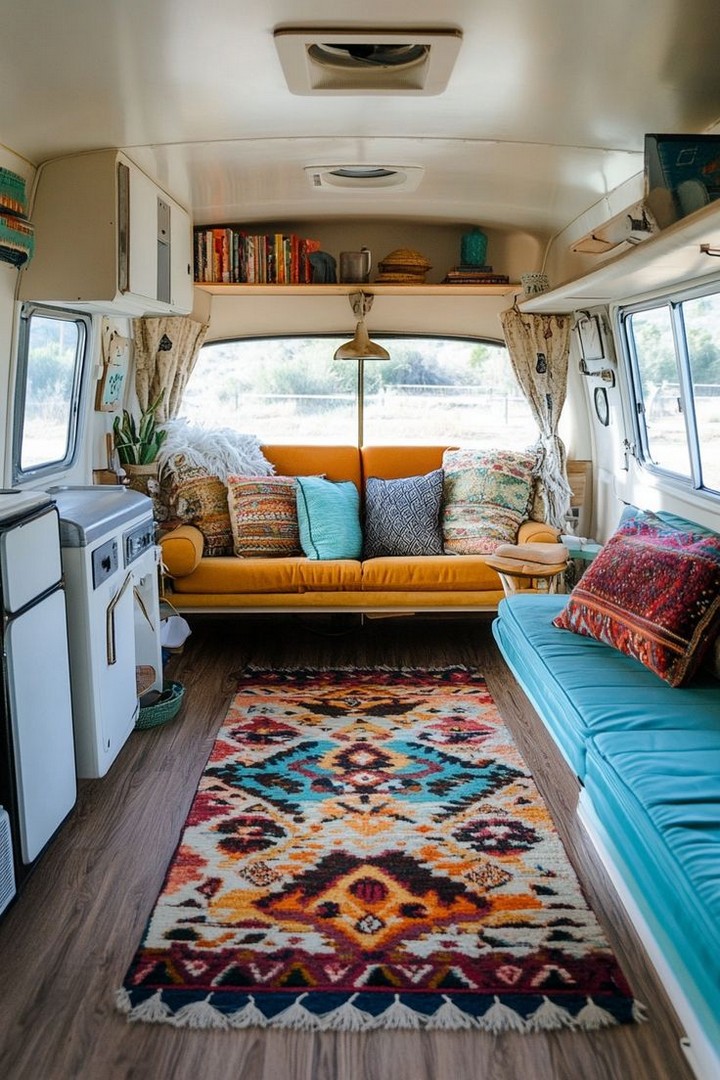
Some skoolie converters create bathroom spaces that emphasize self-care and rejuvenation. These designs might feature copper or stone vessel sinks, rainfall showers, curated lighting schemes, and natural elements like plants or wood accents.
While luxury touches require careful planning in limited space, they transform necessary functions into pleasurable experiences. Details like heated towel bars, essential oil diffusers, or built-in speakers elevate daily routines into mindful practices that enhance overall well-being.
15. The Nature-Connected Composting System
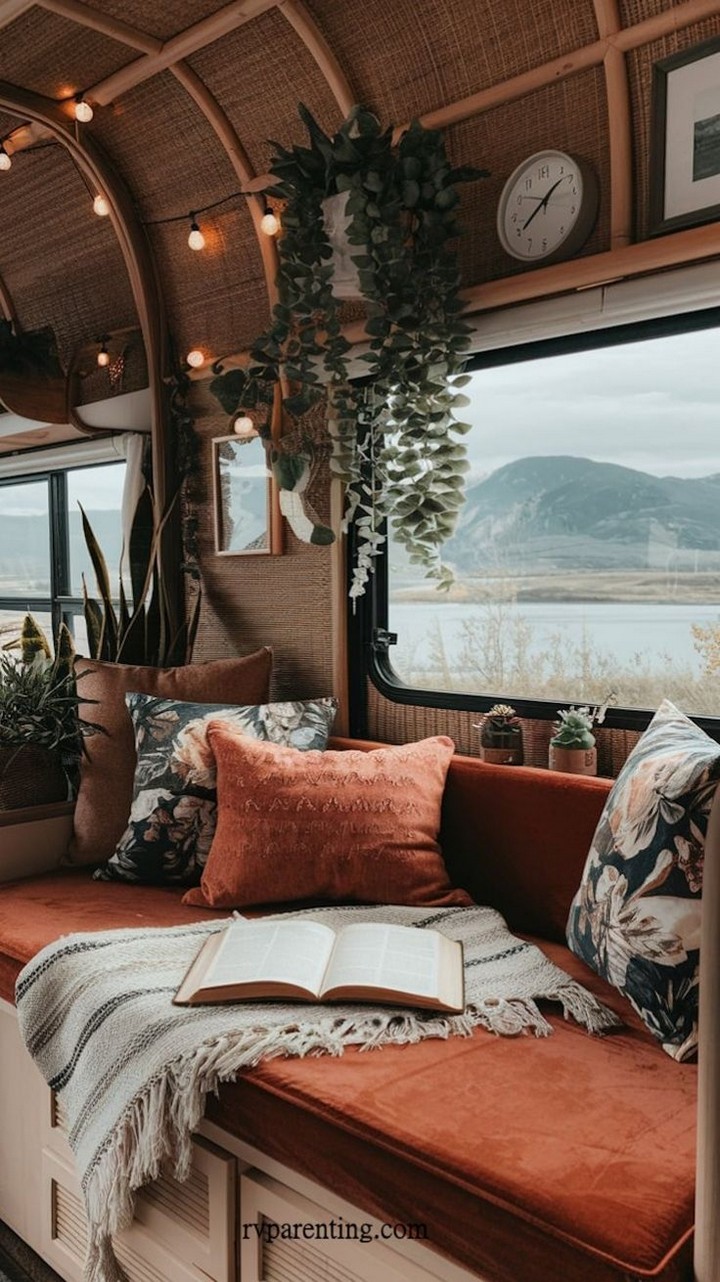
Environmentally conscious skoolie designs often incorporate composting toilets that reduce water usage while creating usable soil amendments. These systems typically require dedicated ventilation but use little to no water, supporting off-grid capabilities.
Modern composting toilet installations can be surprisingly elegant, with wooden enclosures, ceramic bowls, and thoughtful design that aligns with natural living philosophies. When paired with gray water recycling systems for sink and shower water, these bathrooms represent sustainable living principles in action.
Bedroom Configurations
16. The Panoramic Sleeping Bay
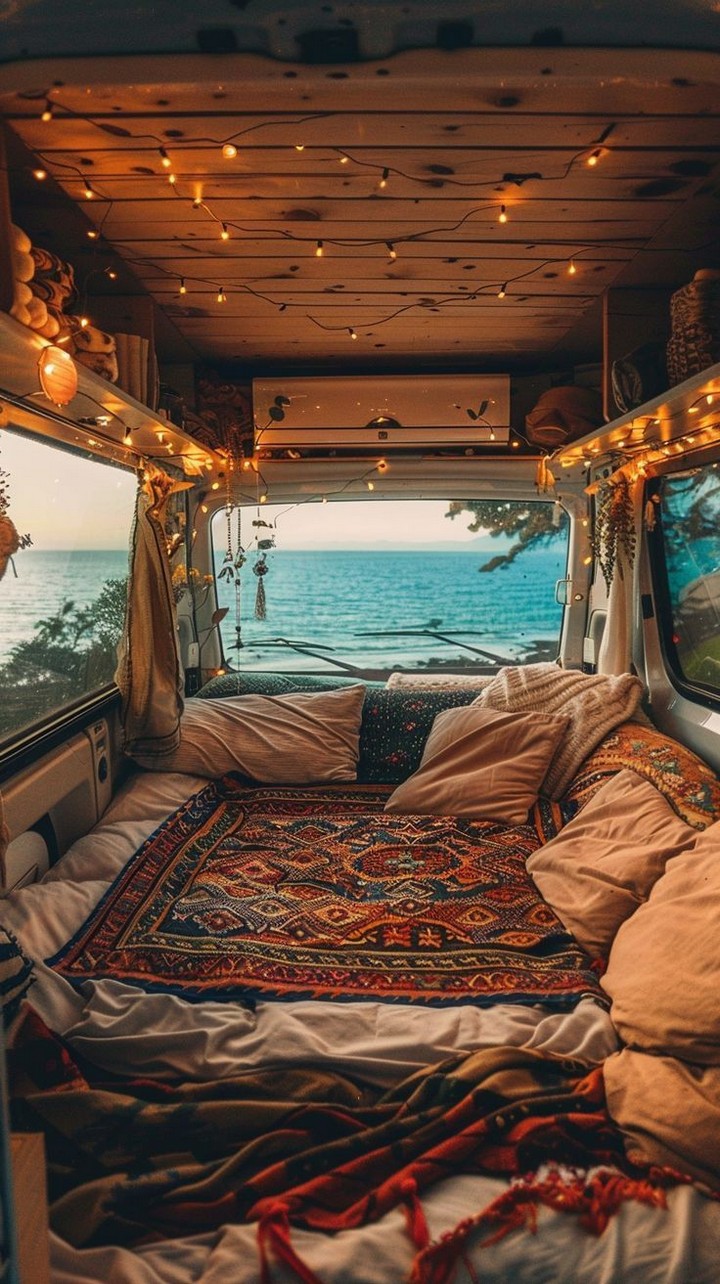
Positioning the bed to maximize views creates magical moments on the road. This concept typically places the mattress perpendicular to the bus length against the rear emergency door or along a wall with extensive windows, allowing occupants to wake up to changing landscapes.
Enhancements might include a custom-built frame that incorporates storage drawers beneath, overhead skylights for stargazing, or window treatments that balance privacy with view preservation. The psychological benefit of connecting with natural surroundings during rest periods makes this design especially appealing for nature enthusiasts.
17. The Bunk System for Families
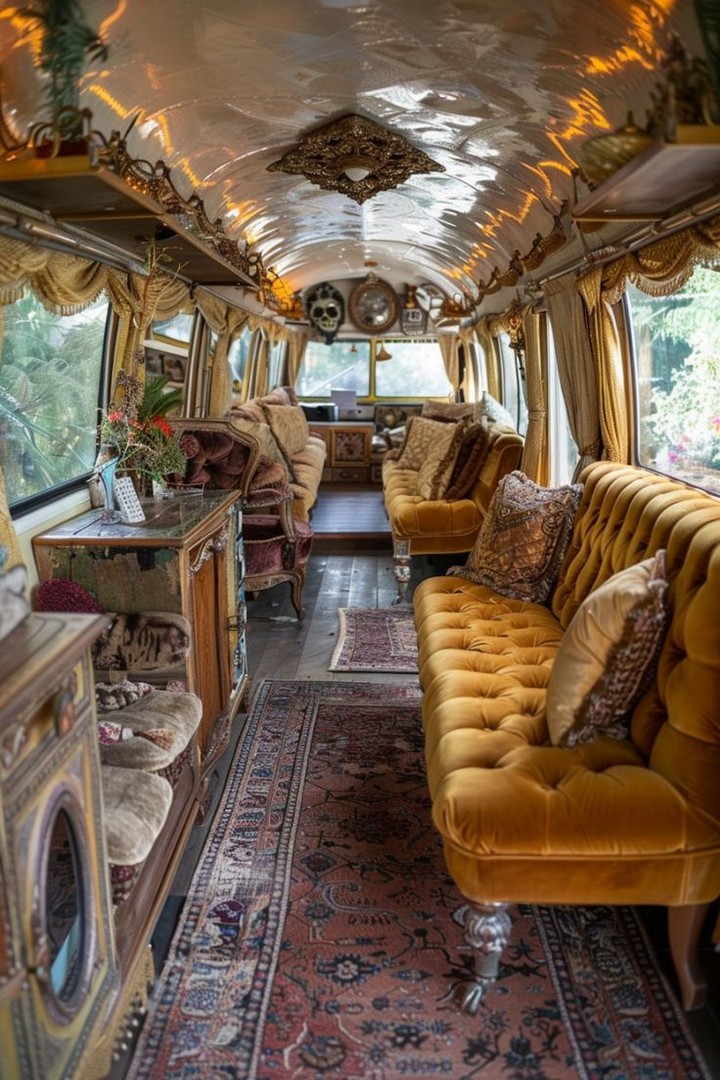
Family-friendly skoolies often incorporate clever bunk arrangements that accommodate children while preserving adult spaces. Designs range from traditional stacked bunks to more creative solutions like pullout trundle beds, murphy bunks that fold against walls when not in use, or elevated sleeping platforms accessible by ladders or stairs.
The most successful family sleeping areas include personalized touches for each child—reading lights, privacy curtains, and small storage areas for treasured items. These thoughtful details help younger travelers feel at home on the road.
18. The Convertible Daytime Space
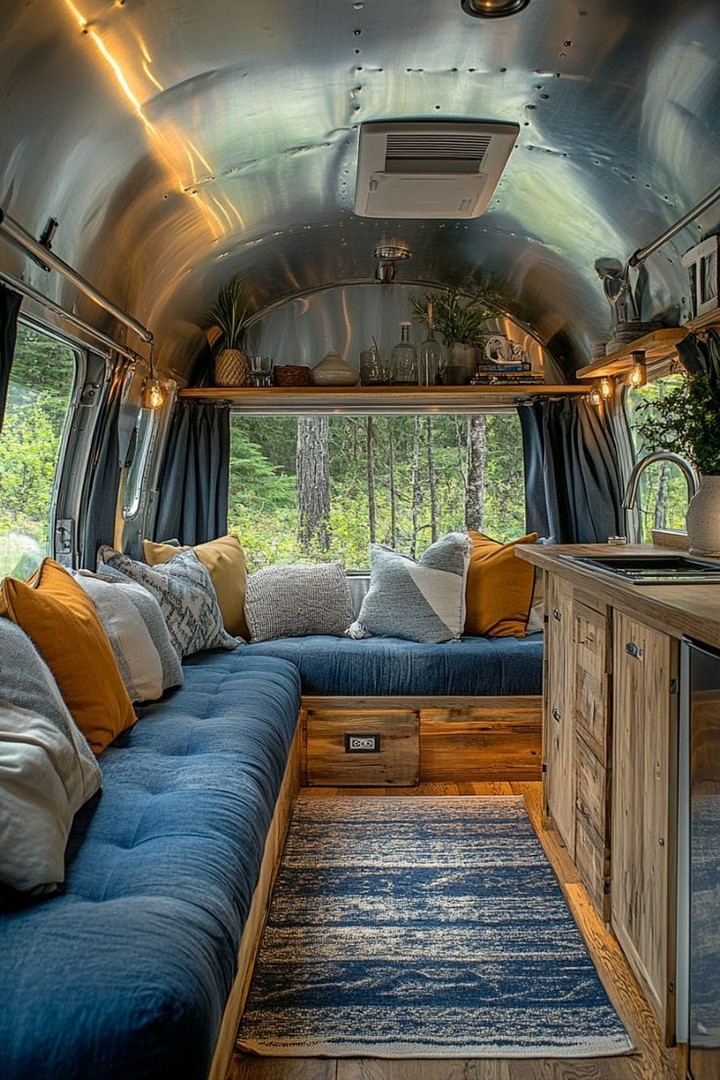
In smaller skoolies, dedicating permanent space to a bed isn’t always practical. Convertible solutions transform sleeping areas into functional daytime living spaces through mechanical or manual conversions.
Popular approaches include platform sofas with cushions that rearrange into mattresses, tables that lower to create bed bases, and murphy beds that fold into walls or cabinets. The key to successful convertible designs lies in creating bedding storage solutions and ensuring the conversion process is simple enough to encourage daily use.
19. The Sleep Sanctuary
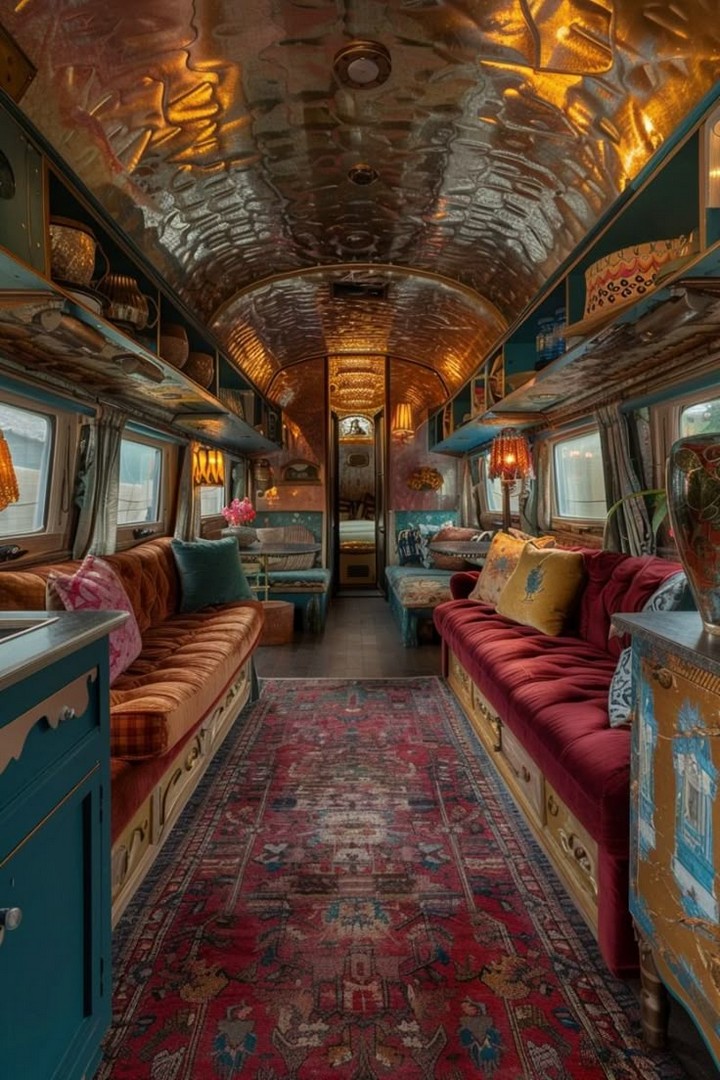
Some skoolie enthusiasts prioritize sleep quality by creating dedicated bedroom spaces that emphasize comfort and restfulness. These designs might feature memory foam mattresses, blackout window coverings, sound insulation in surrounding walls, and carefully controlled temperature and air circulation.
Additional elements often include natural materials like cotton, wool, or linen bedding, absence of electronic devices, and subtle lighting options for creating a gradual transition to sleep. In a lifestyle that can include varied and sometimes challenging environments, a carefully crafted sleep sanctuary provides essential restoration.
20. The Hammock Alternative
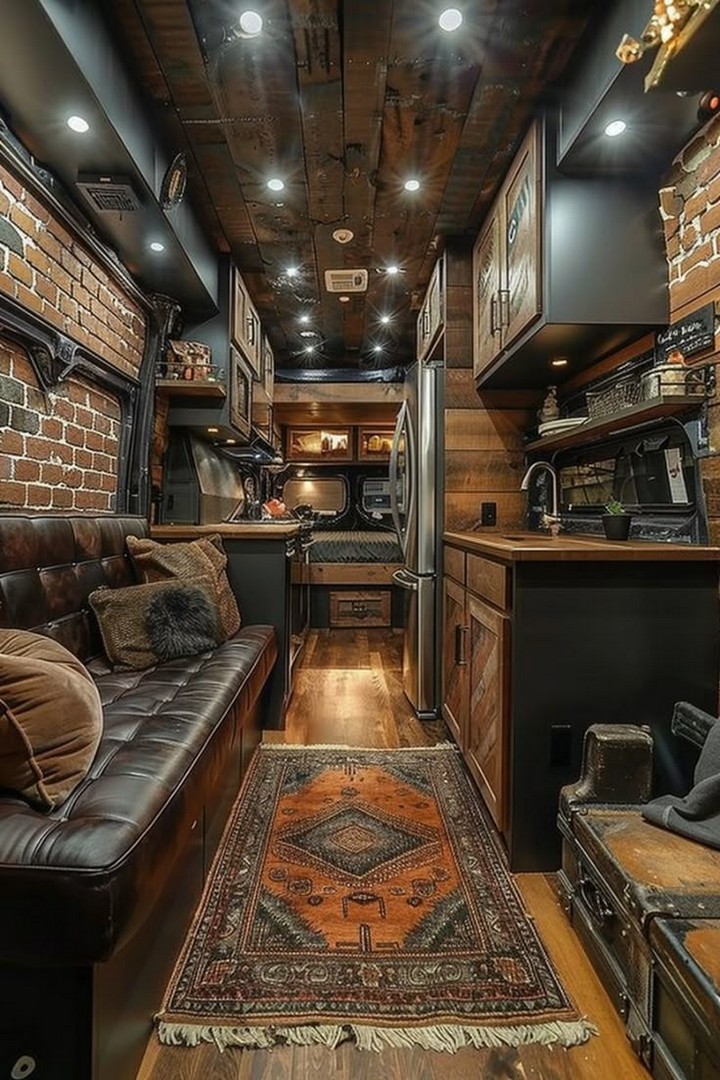
Breaking away from conventional bedding completely, some creative skoolie builds incorporate hammocks as primary or secondary sleeping options. These lightweight, packable solutions can be hung at night and stored during the day, freeing up valuable floor space.
Beyond space efficiency, hammocks offer ergonomic benefits for some sleepers and create a distinctive vacation-like feeling in the living environment. When paired with appropriate structural reinforcement at attachment points, hammocks provide surprisingly comfortable and secure rest while embracing nomadic simplicity.
Multipurpose Living Areas
21. The Mobile Office Setup
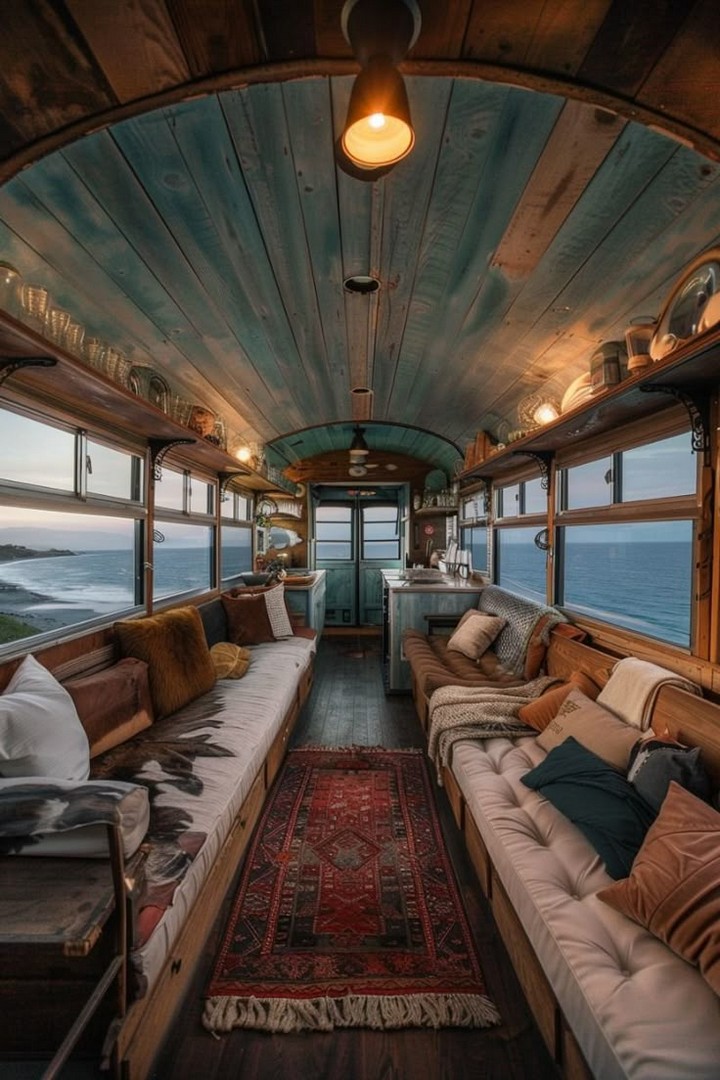
As remote work continues to grow, many skoolie conversions now incorporate dedicated workspace solutions. These range from simple fold-down desks to comprehensive office setups with ergonomic seating, multiple monitors, and professional-grade internet connectivity systems.
Successful mobile offices typically feature abundant electrical outlets, task lighting, storage for documents and equipment, and positioning that captures natural light without screen glare. Some designs include green screens or neutral backgrounds for video conferencing, reflecting the professional needs of digital nomads.
22. The Entertainment-Focused Social Space
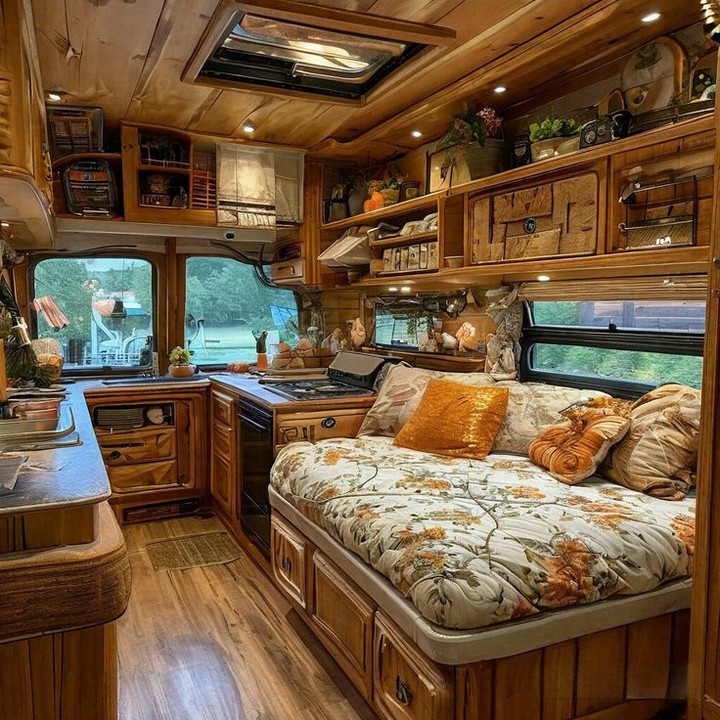
For those who value gathering and recreation, skoolie living areas can be optimized for entertainment. These designs might include surround sound systems, projector screens that descend from the ceiling, gaming stations, or conversation pits with comfortable seating arranged for interaction.
Storage solutions for board games, musical instruments, or media collections integrate these leisure activities into the overall design. The best entertainment-focused skoolies create spaces that transition smoothly from active socializing to relaxed enjoyment.
23. The Indoor-Outdoor Flow Concept
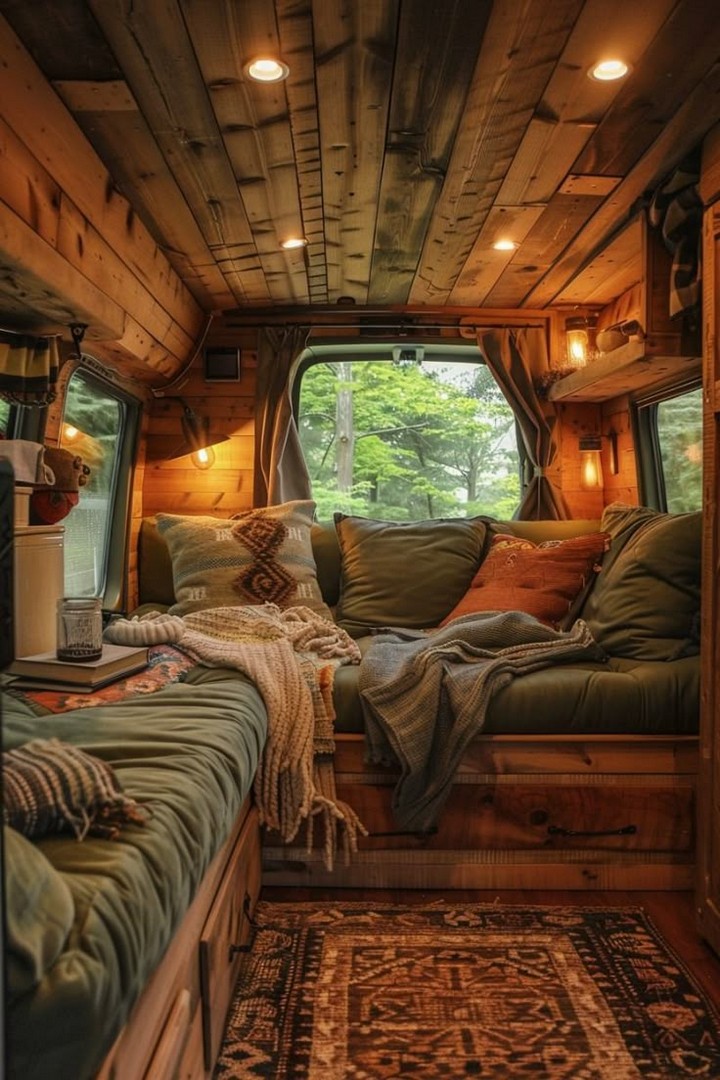
Connecting interior living spaces with the outdoor environment creates an expanded sense of space and facilitates nature connection. This design approach typically features large openable doors (often replacing the standard emergency exit), exterior lighting that extends usable hours, and interior elements that extend outward, like sliding countertops or expandable seating.
Transitional spaces might include awnings, fold-out decks, or outdoor rugs that create defined exterior “rooms.” These elements transform when stationary, temporarily expanding the functional living area well beyond the bus dimensions.
24. The Creative Studio Space
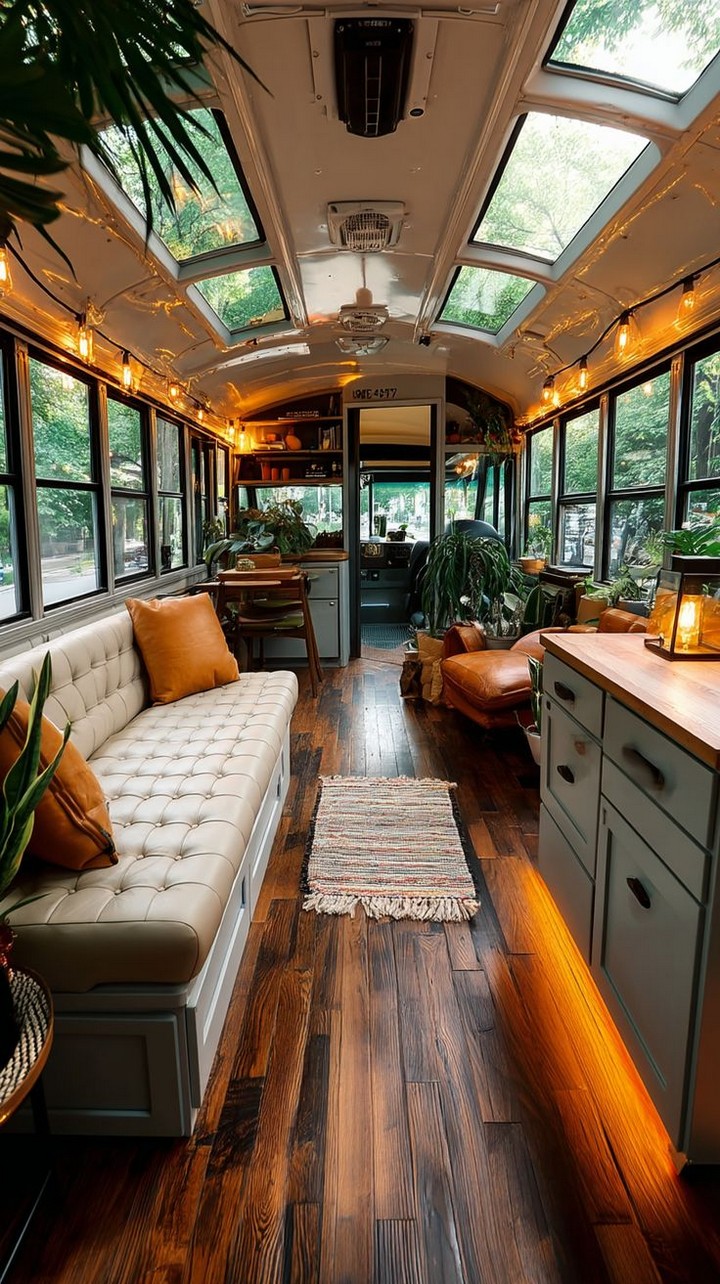
Artists, musicians, craftspeople, and other creators often design skoolies that support their professional or passionate pursuits. These specialized conversions might include features like easels with natural light optimization, sound-dampened recording areas, workbenches with tool storage, or flexible clear floor space for movement activities.
Successful creative spaces typically incorporate abundant storage for materials and equipment, appropriate lighting for detailed work, and surfaces that withstand the rigors of the specific creative process. These thoughtfully designed environments enable creative practices to continue uninterrupted during travel.
25. The Wellness-Centered Living Space
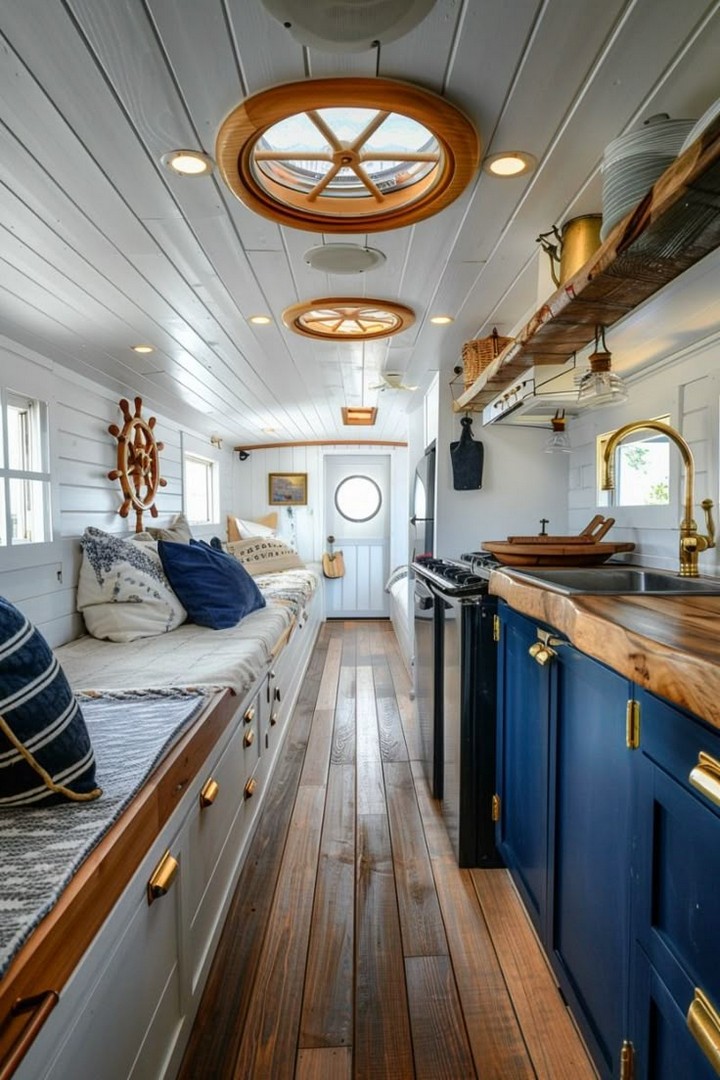
Emphasizing health and well-being, these designs create spaces for movement practices, meditation, or other self-care activities. Features might include open floor areas for yoga or exercise, built-in storage for equipment like resistance bands or weights, and calming color schemes that encourage mindfulness.
Some wellness-focused skoolies incorporate elements like air purification systems, non-toxic building materials, circadian lighting that shifts throughout the day, or dedicated spaces for health-supporting practices like tea preparation or essential oil diffusion.
Exterior Innovations
26. The Rooftop Oasis
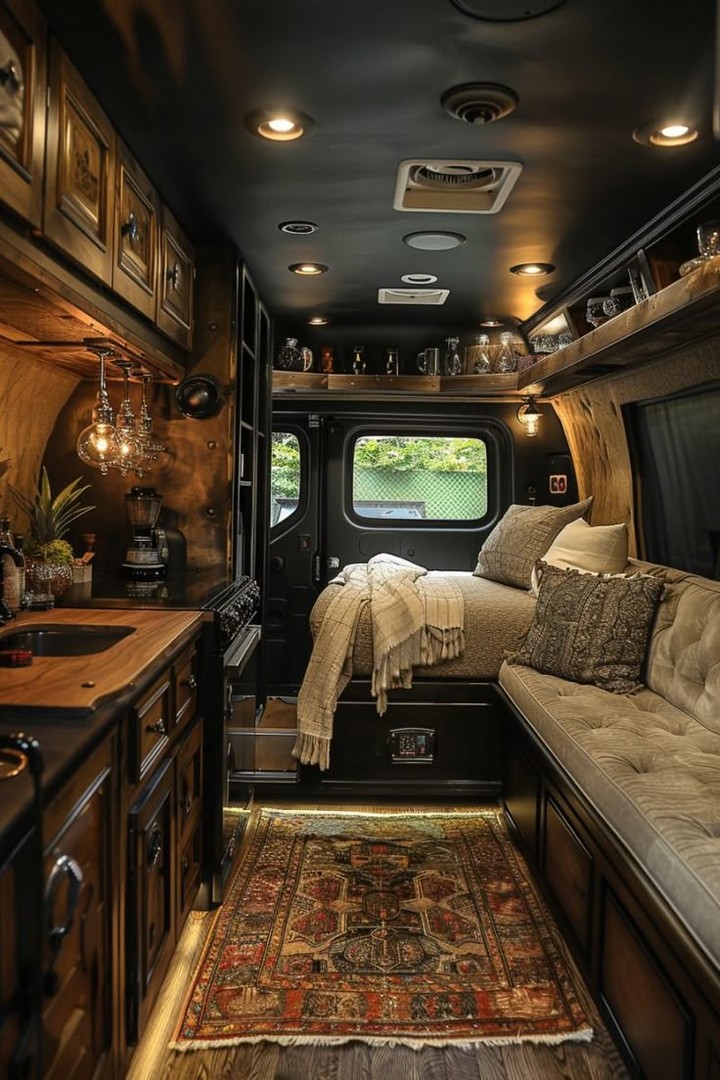
Many skoolie converters utilize the substantial roof space for both functional and recreational purposes. These elevated areas might feature solar panel arrays, outdoor furniture, container gardens, observation decks, or storage for large equipment like paddleboards or kayaks.
Access typically comes via interior ladders, exterior climbing holds, or even spiral staircases integrated into the bus design. The most successful rooftop areas include safety features like railings or defined walking paths while maintaining aerodynamic considerations for road travel.
27. The Expanding Slide-Out Section

Borrowing technology from conventional RVs, some ambitious skoolie builds incorporate slide-out sections that extend living space when parked. These mechanical systems require significant structural modification but can dramatically increase usable square footage during stationary periods.
Common applications include expanding kitchen countertops, creating additional bedroom space, or extending living room areas. While technically challenging, these projects transform the spatial experience of bus living without requiring a larger vehicle.
28. The Attached Deck System
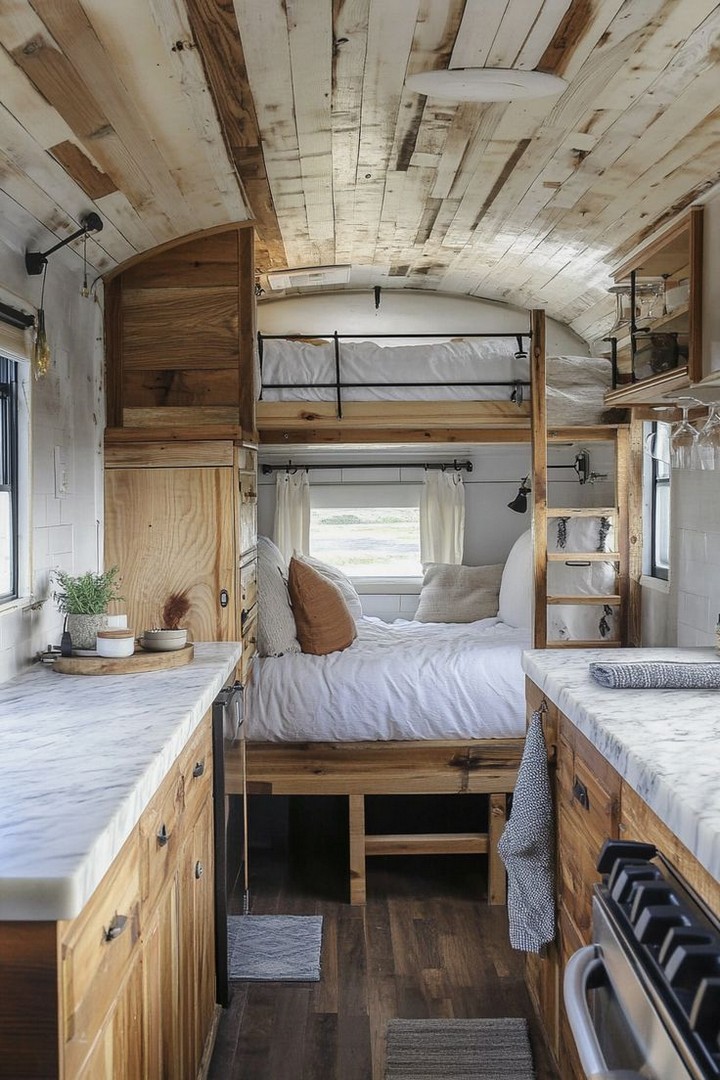
Portable deck systems that attach to the bus when parked create additional outdoor living space perfect for longer stays. Designs range from simple platforms that unfold from storage compartments to elaborate multi-level structures with railings, stairs, and integrated features like outdoor kitchens or shower spaces.
The most practical versions disassemble into components that store compactly within the bus or in underneath compartments. These systems effectively double usable living space while providing the psychological benefit of distinct “indoor” and “outdoor” areas.
29. The Integrated Gear Garage
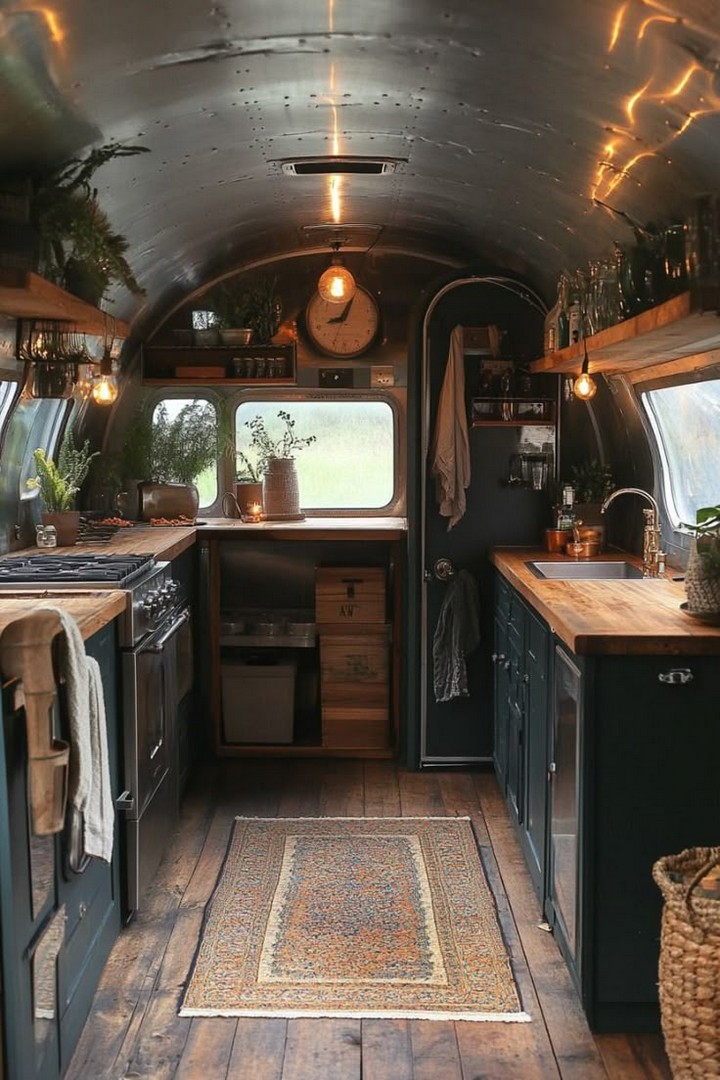
Adventure-focused conversions often incorporate external storage solutions for bulky equipment. These might include custom-built rear boxes, side-mounted containers, undermount drawer systems, or specially designed racks for bicycles, surfboards, climbing gear, or other activity-specific items.
The best designs provide both security and accessibility, with weather protection and organization systems that prevent damage during transit. These thoughtful solutions maintain interior living space while supporting active lifestyle pursuits.
30. The Visual Transformation
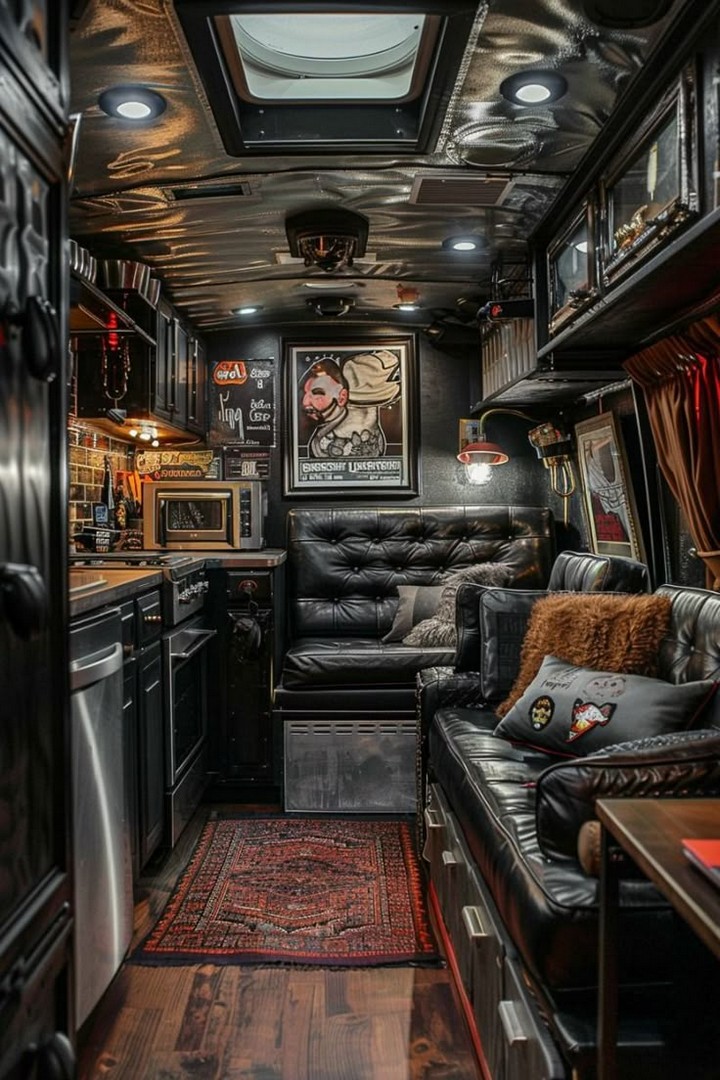
While many skoolie owners embrace the iconic yellow exterior, others completely reimagine the bus’s appearance. Creative exterior treatments include custom paint jobs in unique color schemes, artistic murals that tell personal stories, natural wood cladding that warms the industrial form, or even mosaic tile work that transforms the vehicle into a rolling art piece.
Beyond aesthetics, some exterior modifications serve practical purposes reflective white roof treatments reduce heat absorption, textured coatings provide grip for rooftop activities, or specialized paint formulations resist dust accumulation in desert environments.
Sustainable and Off-Grid Features
31. The Solar-Powered Independent System
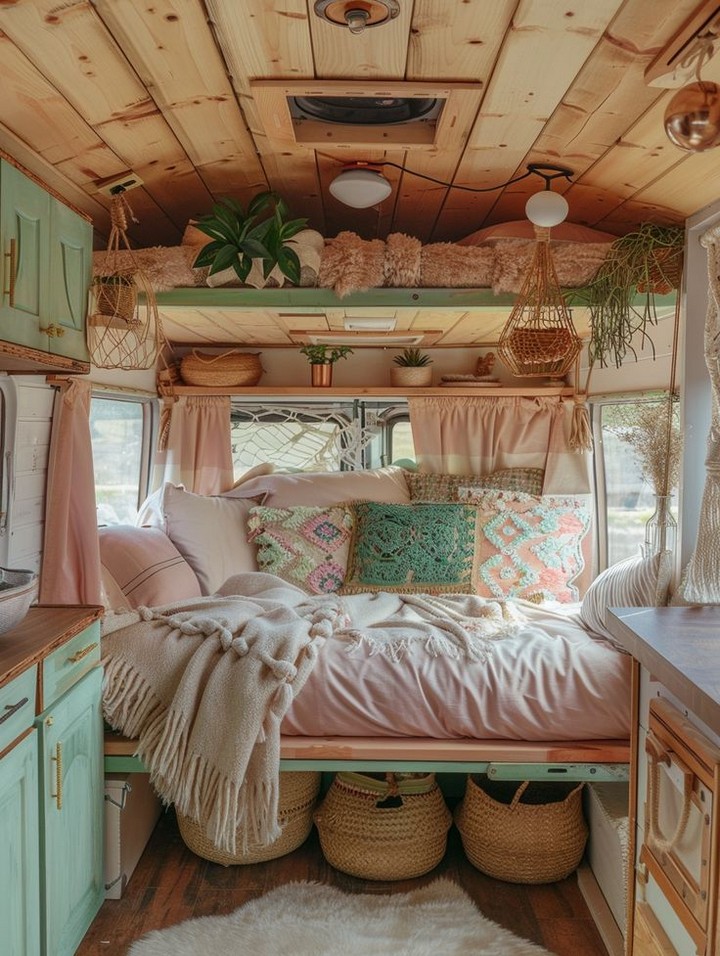
Energy self-sufficiency represents a primary goal for many skoolie enthusiasts. Comprehensive solar setups typically include roof-mounted panels, battery banks sized for specific usage patterns, charge controllers, inverters, and monitoring systems that track production and consumption.
Advanced systems might incorporate hybrid approaches with multiple charging methods—solar as the primary source, alternator charging while driving, shore power connections when available, and possibly backup generators for emergency situations. This redundancy ensures continuous power regardless of conditions.
32. The Water Collection and Filtration Setup
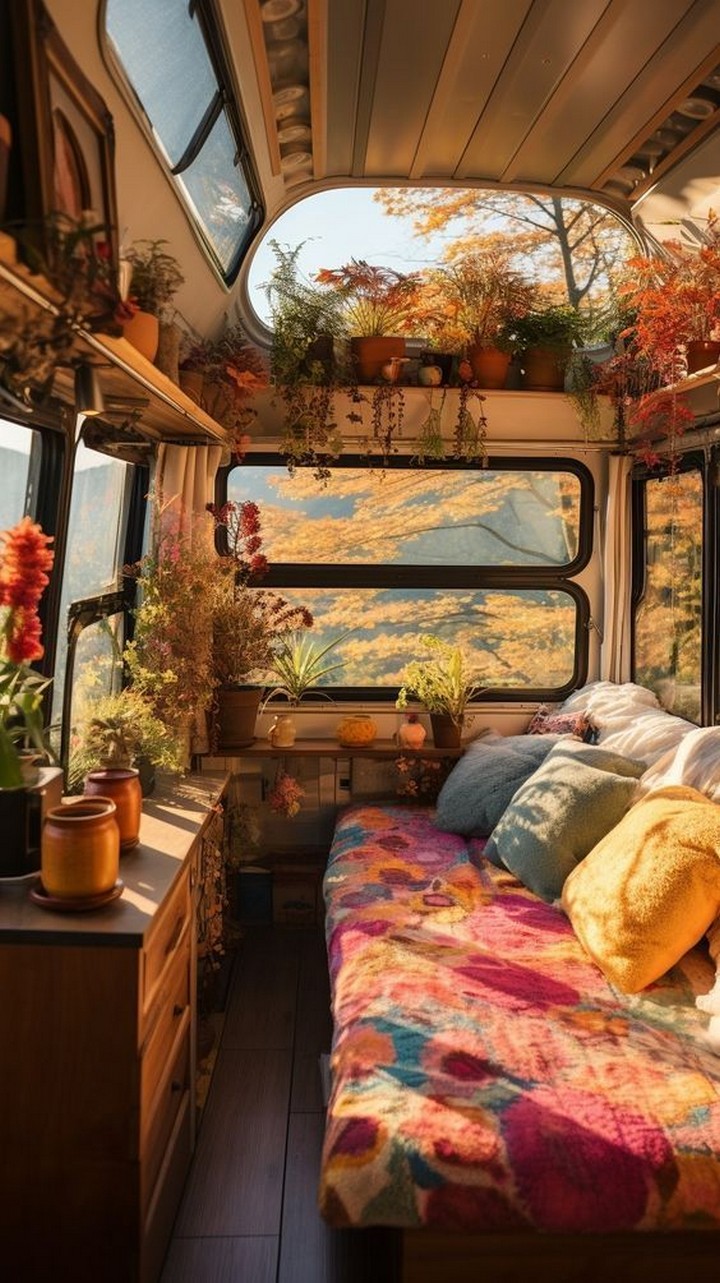
Extending time between fill-ups, rainwater collection systems gather precipitation from the roof into storage tanks. These systems typically include pre-filtering to remove debris, first-flush diverters that bypass initial runoff containing roof contaminants, and appropriate treatment methods for different intended uses.
Complementary filtration systems process water for drinking, cooking, and bathing, with options ranging from simple mechanical filters to sophisticated multi-stage purification including UV sterilization. These systems support extended stays in remote locations while reducing dependence on municipal water sources.
33. The Winter-Ready Four-Season Build
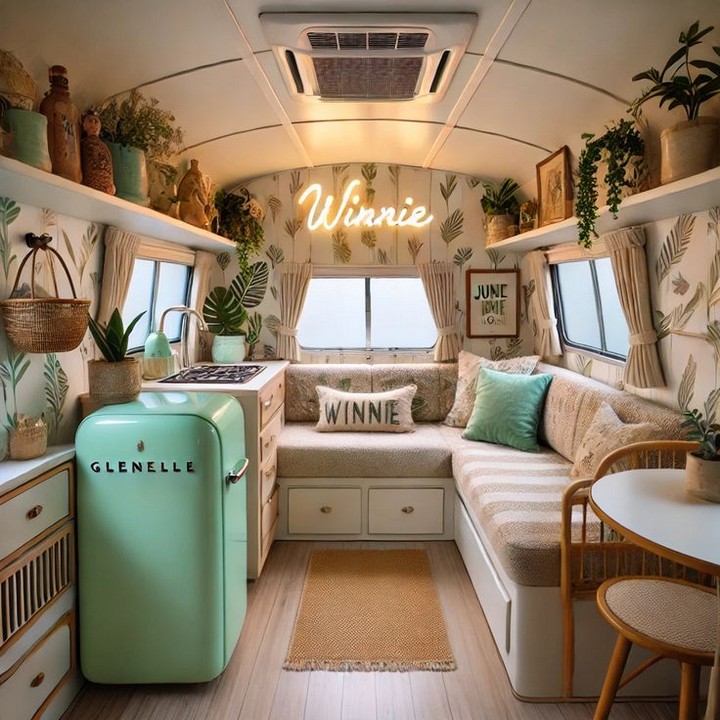
Cold-weather capability expands travel possibilities through seasonal changes. These specialized conversions typically feature enhanced insulation in walls, floor, and ceiling; supplementary heating systems that operate independently from the engine; and careful attention to preventing pipe freezing through strategic placement and heating elements.
Additional winter-focused elements might include entry vestibules that minimize heat loss, window coverings with high R-value, and ventilation systems that exchange air without excessive heat transfer. These adaptations transform school buses originally designed for temperate daytime use into comfortable year-round dwellings.
34. The Permaculture-Inspired Food System
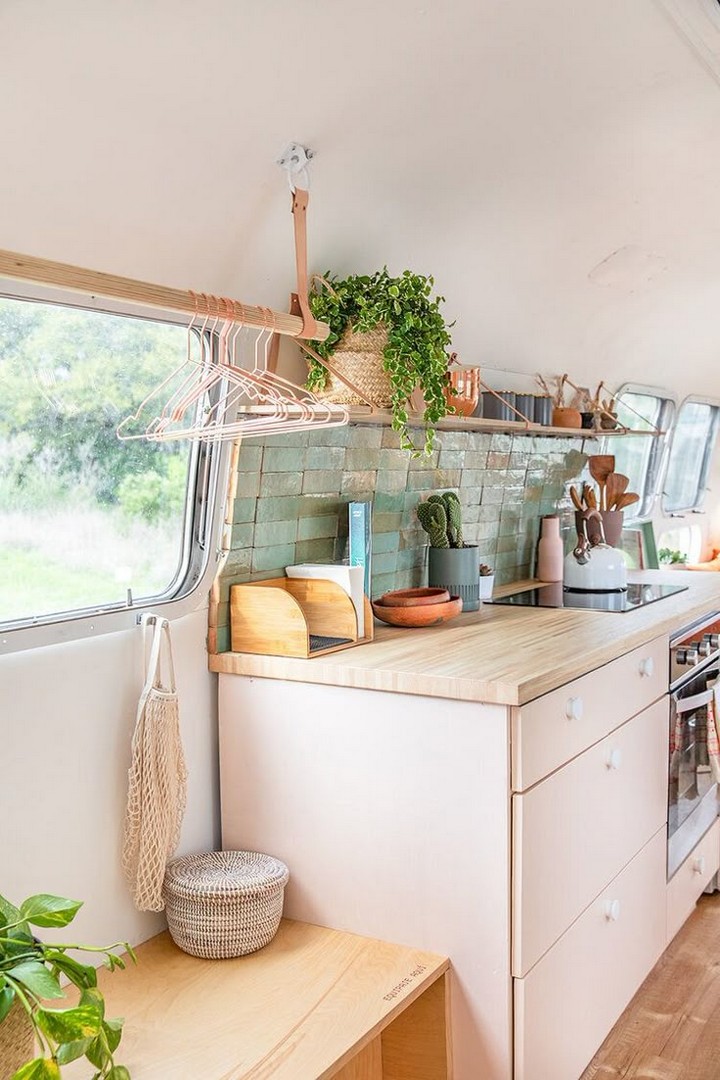
Self-sufficiency extends to food production in some innovative skoolie designs. These might incorporate vertical growing systems mounted on exterior walls, container gardens on roof decks, sprouting stations in kitchen areas, or even small aquaponic systems that combine fish keeping with vegetable production.
Food preservation and preparation equipment supports this approach dehydrators, fermentation vessels, pressure canners, and efficient storage containers extend harvest usability. These systems reduce grocery dependence while connecting occupants with food sources in meaningful ways.
35. The Passive Temperature Regulation Design
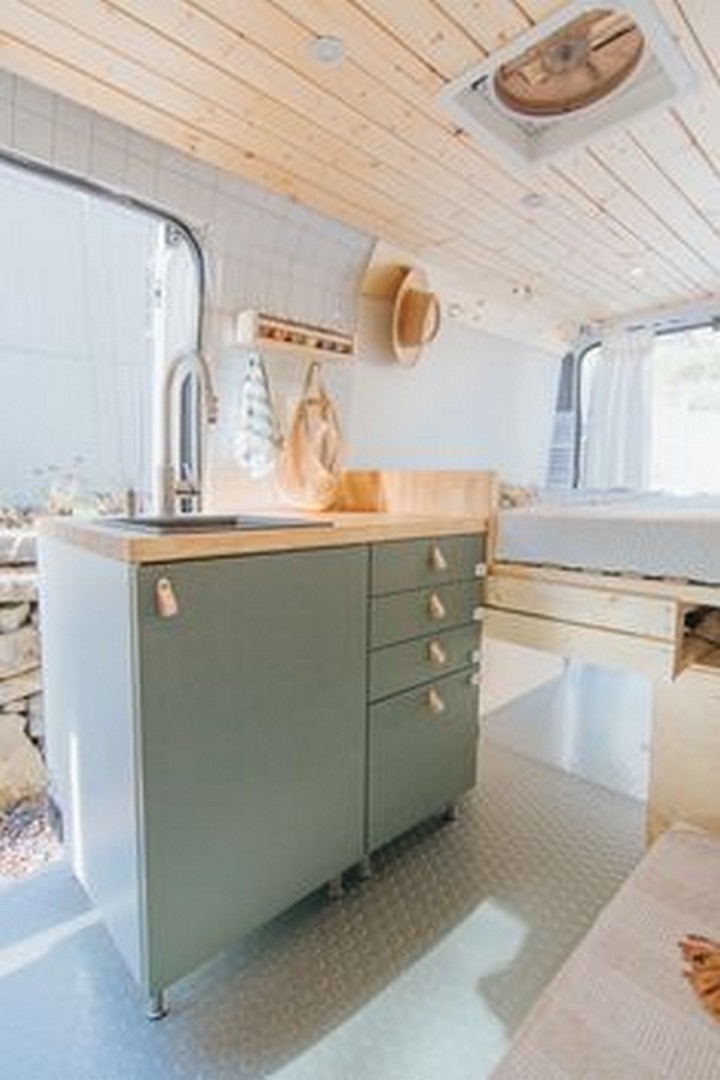
Working with natural principles rather than against them, some skoolie conversions incorporate passive design elements that moderate interior temperatures without active energy use. These might include strategically placed thermal mass that absorbs heat during warm periods and releases it when temperatures drop, carefully planned window placement that captures winter sun while avoiding summer direct exposure, or ventilation pathways that create natural convection currents.
Supplementary features often include awnings or exterior shutters that adjust with seasonal needs, interior curtains that create air pockets for additional insulation, and reflective exterior elements that redirect unwanted solar gain. These thoughtful adaptations reduce the need for mechanical heating and cooling while creating more stable interior comfort.
Turning School Bus Dreams Into Reality
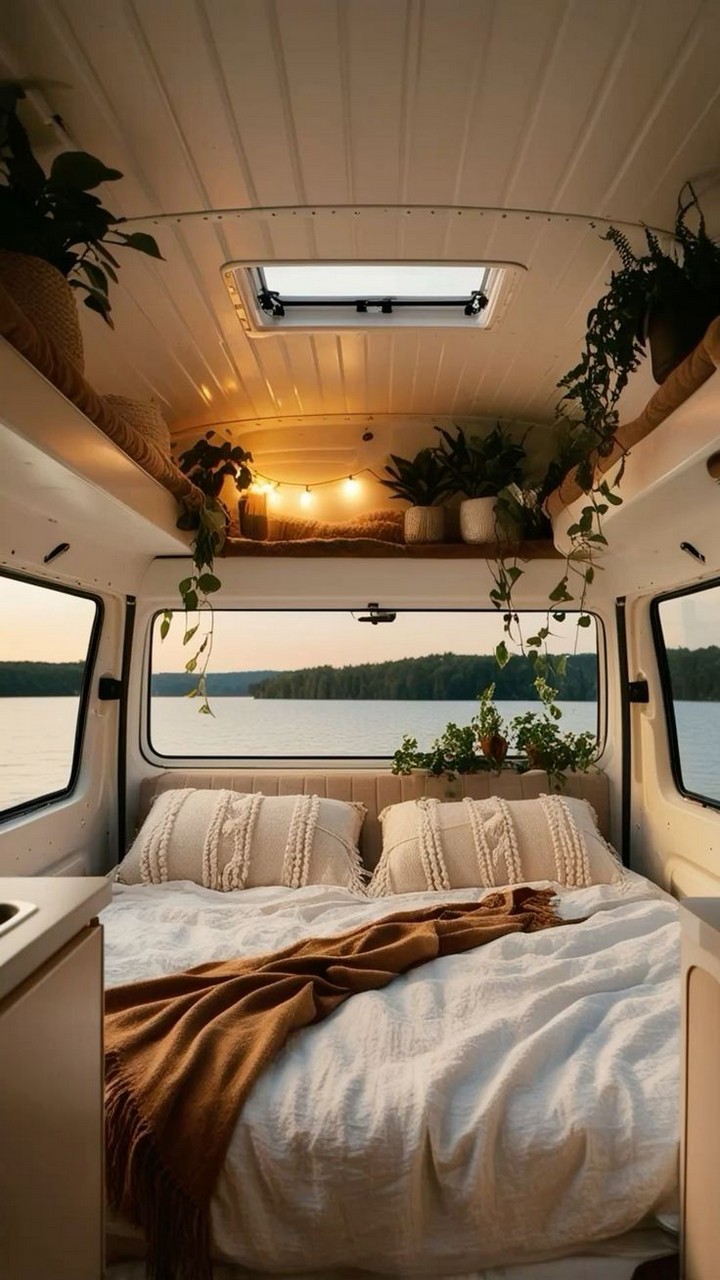
The journey from yellow school bus to personalized rolling home requires vision, planning, and persistence. Whether you’re drawn to minimalist simplicity or elaborate customization, the skoolie lifestyle offers unparalleled freedom to create a home that perfectly matches your needs and aspirations.
Starting your own conversion begins with honest assessment of your goals, skills, budget, and timeline. Many successful builders recommend beginning with extensive research following build journals, joining online communities, and visiting completed skoolies whenever possible to gather ideas and practical insights.
The most satisfying builds typically reflect their owners’ unique priorities rather than following prescribed formulas. By focusing on elements that support your specific lifestyle whether that’s outdoor adventure, creative pursuits, family togetherness, or location-independent work—you’ll create a space that feels authentic and functional for your particular journey.
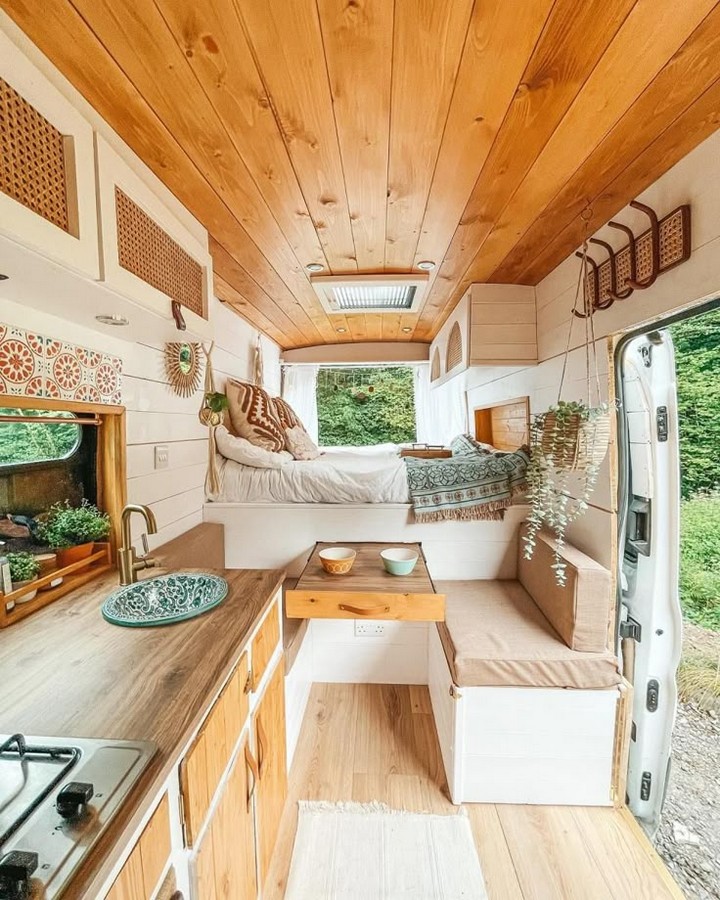
Are you planning a school bus conversion or living the skoolie dream already? We’d love to hear which of these concepts resonates most with your vision or experience! Share your thoughts, questions of your own conversion project in the comments section below.
For more inspiration on alternative living spaces, DIY conversion projects, and mobile lifestyle tips, subscribe to our newsletter and join our growing community of road-based adventurers. The possibilities are as limitless as the open road ahead!
With these ideas, you can hit the road in style and make your skoolie dreams a reality. Happy travels! 🚌✨

